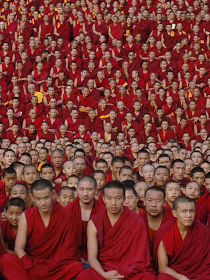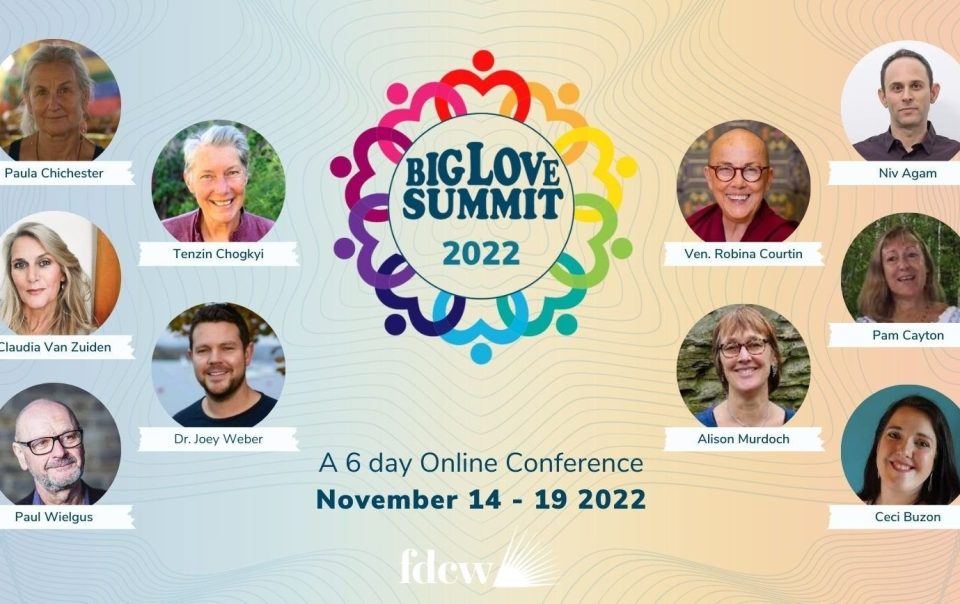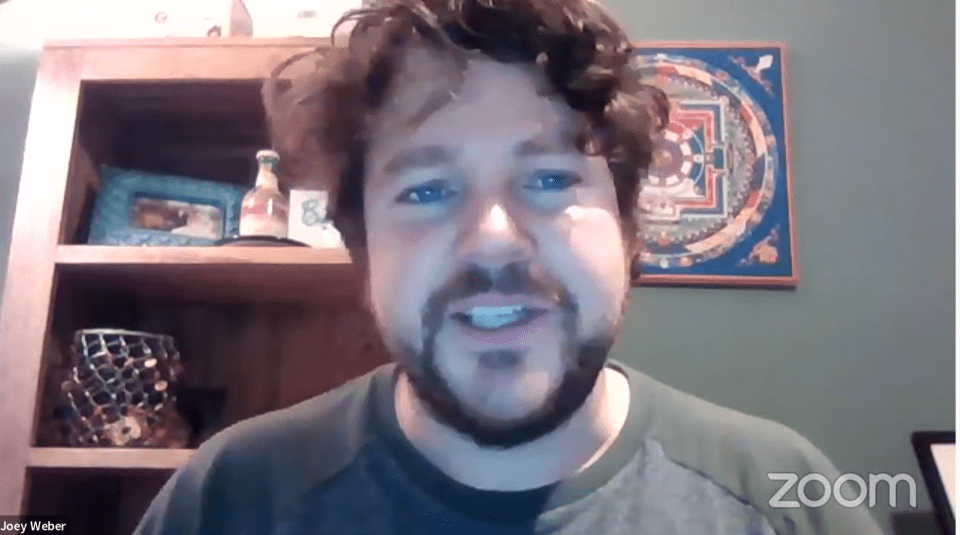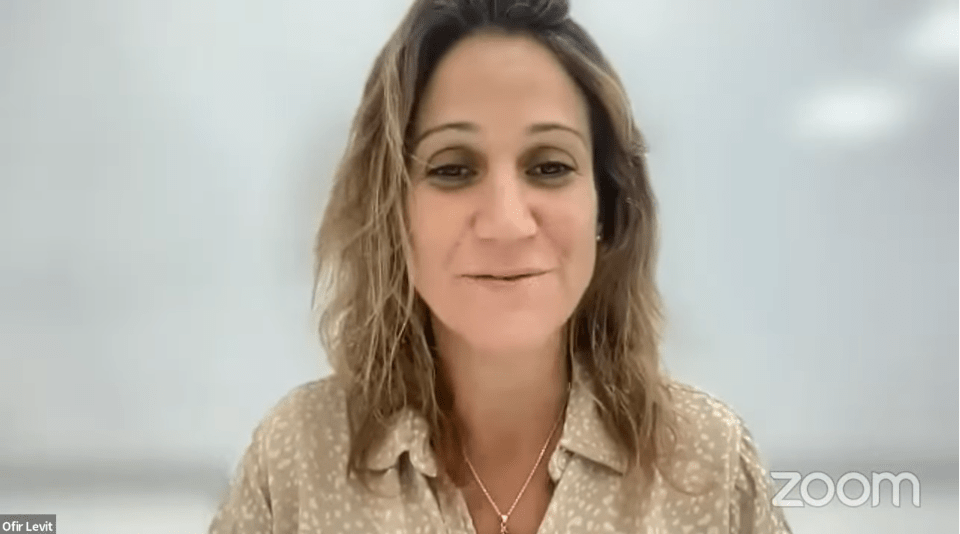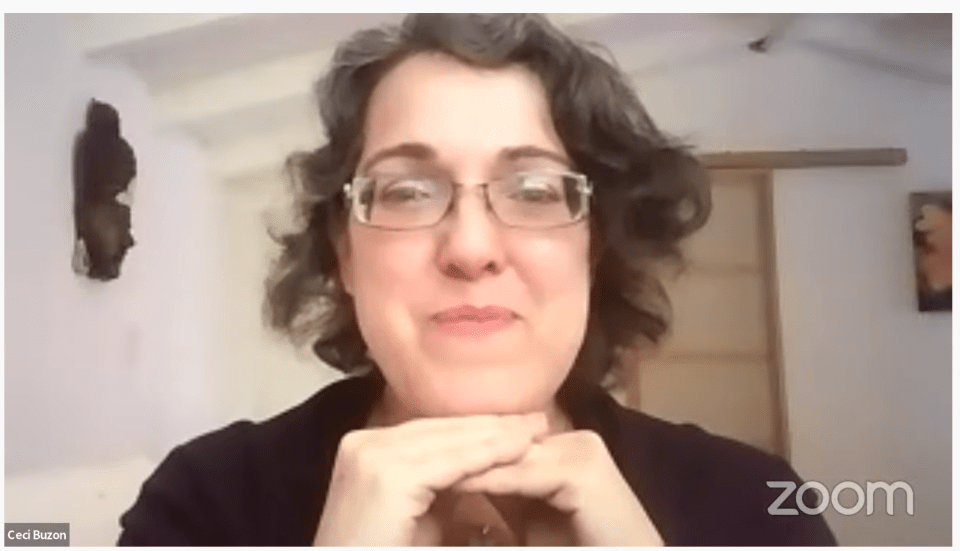- Home
- FPMT Homepage
Foundation for the Preservation of the Mahayana Tradition
The FPMT is an organization devoted to preserving and spreading Mahayana Buddhism worldwide by creating opportunities to listen, reflect, meditate, practice and actualize the unmistaken teachings of the Buddha and based on that experience spreading the Dharma to sentient beings. We provide integrated education through which people’s minds and hearts can be transformed into their highest potential for the benefit of others, inspired by an attitude of universal responsibility and service. We are committed to creating harmonious environments and helping all beings develop their full potential of infinite wisdom and compassion. Our organization is based on the Buddhist tradition of Lama Tsongkhapa of Tibet as taught to us by our founders Lama Thubten Yeshe and Lama Thubten Zopa Rinpoche.
- Willkommen
Die Stiftung zur Erhaltung der Mahayana Tradition (FPMT) ist eine Organisation, die sich weltweit für die Erhaltung und Verbreitung des Mahayana-Buddhismus einsetzt, indem sie Möglichkeiten schafft, den makellosen Lehren des Buddha zuzuhören, über sie zur reflektieren und zu meditieren und auf der Grundlage dieser Erfahrung das Dharma unter den Lebewesen zu verbreiten.
Wir bieten integrierte Schulungswege an, durch denen der Geist und das Herz der Menschen in ihr höchstes Potential verwandelt werden zum Wohl der anderen – inspiriert durch eine Haltung der universellen Verantwortung und dem Wunsch zu dienen. Wir haben uns verpflichtet, harmonische Umgebungen zu schaffen und allen Wesen zu helfen, ihr volles Potenzial unendlicher Weisheit und grenzenlosen Mitgefühls zu verwirklichen.
Unsere Organisation basiert auf der buddhistischen Tradition von Lama Tsongkhapa von Tibet, so wie sie uns von unseren Gründern Lama Thubten Yeshe und Lama Thubten Zopa Rinpoche gelehrt wird.
- Bienvenidos
La Fundación para la preservación de la tradición Mahayana (FPMT) es una organización que se dedica a preservar y difundir el budismo Mahayana en todo el mundo, creando oportunidades para escuchar, reflexionar, meditar, practicar y actualizar las enseñanzas inconfundibles de Buda y en base a esa experiencia difundir el Dharma a los seres.
Proporcionamos una educación integrada a través de la cual las mentes y los corazones de las personas se pueden transformar en su mayor potencial para el beneficio de los demás, inspirados por una actitud de responsabilidad y servicio universales. Estamos comprometidos a crear ambientes armoniosos y ayudar a todos los seres a desarrollar todo su potencial de infinita sabiduría y compasión.
Nuestra organización se basa en la tradición budista de Lama Tsongkhapa del Tíbet como nos lo enseñaron nuestros fundadores Lama Thubten Yeshe y Lama Zopa Rinpoche.
A continuación puede ver una lista de los centros y sus páginas web en su lengua preferida.
- Bienvenue
L’organisation de la FPMT a pour vocation la préservation et la diffusion du bouddhisme du mahayana dans le monde entier. Elle offre l’opportunité d’écouter, de réfléchir, de méditer, de pratiquer et de réaliser les enseignements excellents du Bouddha, pour ensuite transmettre le Dharma à tous les êtres. Nous proposons une formation intégrée grâce à laquelle le cœur et l’esprit de chacun peuvent accomplir leur potentiel le plus élevé pour le bien d’autrui, inspirés par le sens du service et une responsabilité universelle. Nous nous engageons à créer un environnement harmonieux et à aider tous les êtres à épanouir leur potentiel illimité de compassion et de sagesse. Notre organisation s’appuie sur la tradition guéloukpa de Lama Tsongkhapa du Tibet, telle qu’elle a été enseignée par nos fondateurs Lama Thoubtèn Yéshé et Lama Zopa Rinpoché.
Visitez le site de notre Editions Mahayana pour les traductions, conseils et nouvelles du Bureau international en français.
Voici une liste de centres et de leurs sites dans votre langue préférée
- Benvenuto
L’FPMT è un organizzazione il cui scopo è preservare e diffondere il Buddhismo Mahayana nel mondo, creando occasioni di ascolto, riflessione, meditazione e pratica dei perfetti insegnamenti del Buddha, al fine di attualizzare e diffondere il Dharma fra tutti gli esseri senzienti.
Offriamo un’educazione integrata, che può trasformare la mente e i cuori delle persone nel loro massimo potenziale, per il beneficio di tutti gli esseri, ispirati da un’attitudine di responsabilità universale e di servizio.
Il nostro obiettivo è quello di creare contesti armoniosi e aiutare tutti gli esseri a sviluppare in modo completo le proprie potenzialità di infinita saggezza e compassione.
La nostra organizzazione si basa sulla tradizione buddhista di Lama Tsongkhapa del Tibet, così come ci è stata insegnata dai nostri fondatori Lama Thubten Yeshe e Lama Zopa Rinpoche.
Di seguito potete trovare un elenco dei centri e dei loro siti nella lingua da voi prescelta.
- 欢迎 / 歡迎
简体中文
“护持大乘法脉基金会”( 英文简称:FPMT。全名:Foundation for the Preservation of the Mahayana Tradition) 是一个致力于护持和弘扬大乘佛法的国际佛教组织。我们提供听闻,思维,禅修,修行和实证佛陀无误教法的机会,以便让一切众生都能够享受佛法的指引和滋润。
我们全力创造和谐融洽的环境, 为人们提供解行并重的完整佛法教育,以便启发内在的环宇悲心及责任心,并开发内心所蕴藏的巨大潜能 — 无限的智慧与悲心 — 以便利益和服务一切有情。
FPMT的创办人是图腾耶喜喇嘛和喇嘛梭巴仁波切。我们所修习的是由两位上师所教导的,西藏喀巴大师的佛法传承。
繁體中文
護持大乘法脈基金會”( 英文簡稱:FPMT。全名:Found
ation for the Preservation of the Mahayana Tradition ) 是一個致力於護持和弘揚大乘佛法的國際佛教組織。我們提供聽聞, 思維,禪修,修行和實證佛陀無誤教法的機會,以便讓一切眾生都能 夠享受佛法的指引和滋潤。 我們全力創造和諧融洽的環境,
為人們提供解行並重的完整佛法教育,以便啟發內在的環宇悲心及責 任心,並開發內心所蘊藏的巨大潛能 — 無限的智慧與悲心 – – 以便利益和服務一切有情。 FPMT的創辦人是圖騰耶喜喇嘛和喇嘛梭巴仁波切。
我們所修習的是由兩位上師所教導的,西藏喀巴大師的佛法傳承。 察看道场信息:
- FPMT Homepage
- News/Media
-
- Study & Practice
-
-
- About FPMT Education Services
- Latest News
- Programs
- New to Buddhism?
- Buddhist Mind Science: Activating Your Potential
- Heart Advice for Death and Dying
- Discovering Buddhism
- Living in the Path
- Exploring Buddhism
- FPMT Basic Program
- FPMT Masters Program
- FPMT In-Depth Meditation Training
- Maitripa College
- Lotsawa Rinchen Zangpo Translator Program
- Universal Education for Compassion & Wisdom
- Online Learning Center
-
- Prayers & Practice Materials
- Overview of Prayers & Practices
- Full Catalogue of Prayers & Practice Materials
- Explore Popular Topics
- Benefiting Animals
- Chenrezig Resources
- Death & Dying Resources
- Lama Chopa (Guru Puja)
- Lama Zopa Rinpoche: Compendium of Precious Instructions
- Lama Zopa Rinpoche: Life Practice Advice
- Lama Zopa Rinpoche Practice Series
- Lamrim Resources
- Mantras
- Prayer Book Updates
- Purification Practices
- Sutras
- Thought Transformation (Lojong)
- Audio Materials
- Dharma Dates - Tibetan Calendar
- Translation Services
- Publishing Services
- Ways to Offer Support
- Prayers & Practice Materials
-
- Teachings and Advice
- Find Teachings and Advice
- Lama Zopa Rinpoche Advice Page
- Lama Zopa Rinpoche: Compendium of Precious Instructions
- Lama Zopa Rinpoche Video Teachings
- ༧སྐྱབས་རྗེ་བཟོད་པ་རིན་པོ་ཆེ་མཆོག་ནས་སྩལ་བའི་བཀའ་སློབ་བརྙན་འཕྲིན།
- Podcasts
- Lama Yeshe Wisdom Archive
- Buddhism FAQ
- Dharma for Young People
- Resources on Holy Objects
- Teachings and Advice
-
-
*If a menu item has a submenu clicking once will expand the menu clicking twice will open the page.
-
-
- Centers
-
- Teachers
-
- Projects
-
-
-
-
*If a menu item has a submenu clicking once will expand the menu clicking twice will open the page.
-
-
- FPMT
-
-
-
-
-
Like molding dough in your hand, you can definitely turn your mind whichever way you want.
Lama Zopa Rinpoche
-
-
-
- Shop
-
-
-
The Foundation Store is FPMT’s online shop and features a vast selection of Buddhist study and practice materials written or recommended by our lineage gurus. These items include homestudy programs, prayers and practices in PDF or eBook format, materials for children, and other resources to support practitioners.
Items displayed in the shop are made available for Dharma practice and educational purposes, and never for the purpose of profiting from their sale. Please read FPMT Foundation Store Policy Regarding Dharma Items for more information.
-
-
FPMT Community: Stories & News
26
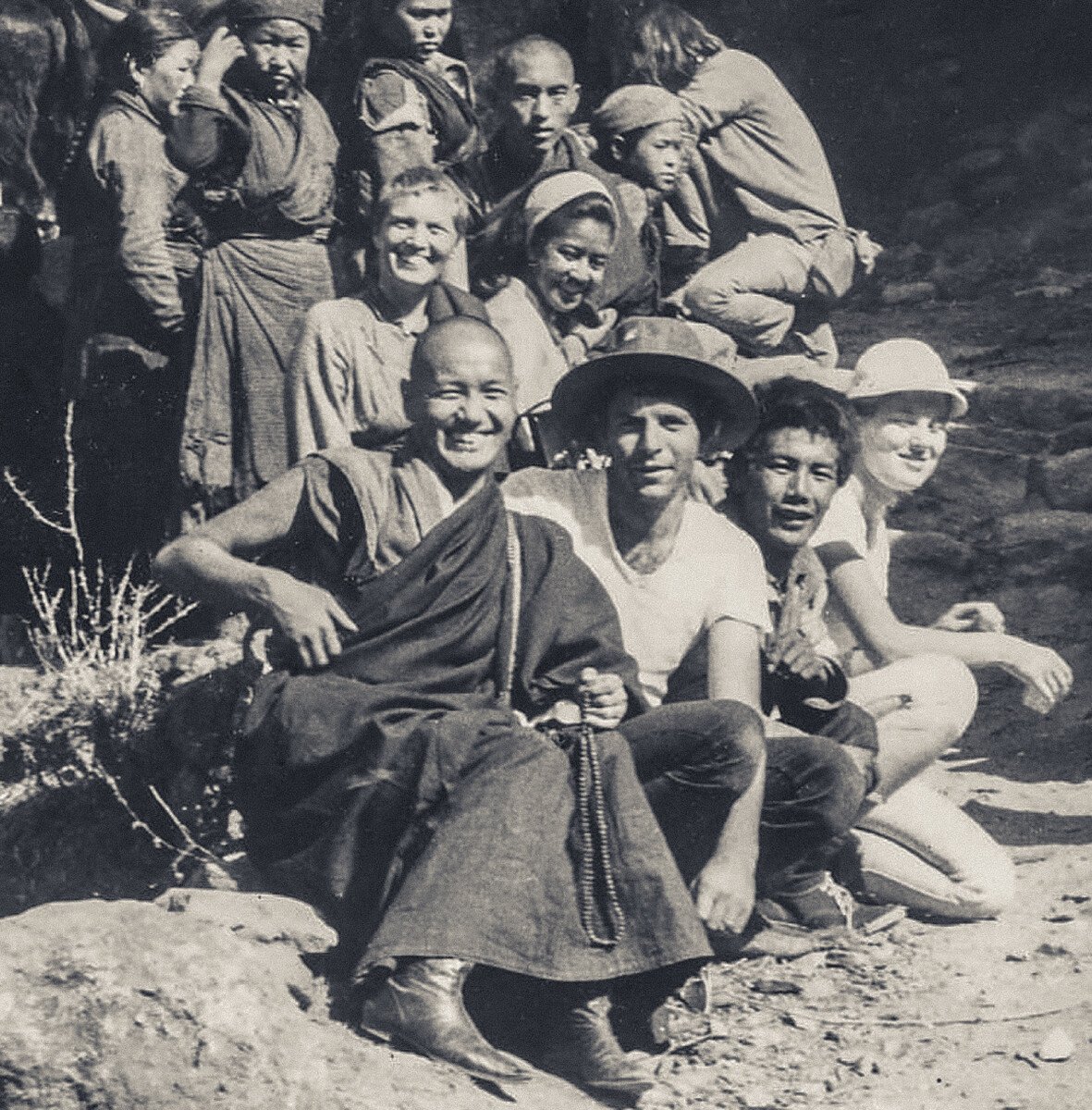
The trekking group to Lawudo, pictured from front: Lama Yeshe, Chip Weitzner, Dorje Sherpa, Judy Weitzner. Above: Zina, Max, and behind Max, Lama Zopa Rinpoche. Photo courtesy of Lama Yeshe Wisdom Archive.
Below is Judy Weitzner’s extraordinary and historic account of a very early visit to Solu Khumbu, Nepal with Lama Yeshe and Lama Zopa Rinpoche in 1969. This was the first time that Rinpoche had returned to Lawudo since he left for Tibet as a young boy and the group included Zina Rachevsky and Max Mathews.
This story was first published in three parts in the Love Lawudo monthly newsletters #11, #12 and #13. We’ve added many photos from the Lama Yeshe Wisdom Archive collection for this posting. We hope you enjoy!
Introduction
In the Fall of 1968, Chip Weitzner and I took off on a round the world adventure. For months prior to leaving I brought home stacks of books from the Richmond Library, compiling a list of all the intriguing spots in various countries around the globe. I listed the sites on index cards for each country we might visit and compiled a manilla file. Some stops were clear. We knew we would stop in Hong Kong to see Chip’s sister, Janet who was a China scholar. We had promised a Peace Corps friend that we would visit him in Nepal. When it came time to purchase a round the world ticket for $1258.00, I discovered that we were allowed as many stopovers as we wanted, as long as we went forward and did not zig or zag excessively. Basically, I put every place on the ticket that we might want to visit, north of the equator. The ticket was well over an inch thick, and shocked every airline and travel agent who handled it. We stayed a week or two at each destination. Hawaii, Japan, Hong Kong, Macau, Cambodia, Thailand, Malaysia, Singapore, Indonesia, Bali, India,…and, then, NEPAL!! “You must see the Himalayas before you die” was a quote that drove me.
Nepal in 1968 had not been open to tourists for very long. Most who came were mountaineers who stayed in the Yak and Yeti hotel. We stayed at the Panorama Hotel, a hang out for anthropologists in Kathmandu taking a break from their field studies and for various government aid workers.
Early on, a Peace Corps friend took us out for lunch at the Peace Restaurant, across from the American Embassy. It was reputedly a safe restaurant to eat in, and by our standards was very inexpensive. Hanging on the wall was a map of the flags of the world. I studied it from afar while eating my lunch. I spied a unique looking flag, a kind of double pennant that featured the sun and the moon on the two parts. I had always been attracted to the symbology of the sun and moon, so I announced to my friends that I saw a flag I liked and wanted to go to that country. I walked up to the map to find out that it was Nepal’s flag. I said, “Well, I guess I am where I want to be, then.”
We stayed in Nepal from November 1968 until June 1969. We secured teaching jobs at the American International School, which was a means of support as well as a long visa. I taught 3rd grade and Chip taught PE. Max Mathews was the beautiful and creative 4th grade teacher as well as the proprietor of Max’s Gallery. We soon became friends, spending much of our weekend time together. She would send her driver and car – a red, mile-long 1932 Hudson – to pick us up after we settled in a small house out in the countryside. Her “penthouse apartment” on the upper two floors and roof of a downtown building was a salon of sorts. She had lived and taught in many exotic places, and friends of hers would drop in on their travels through Kathmandu.
It was at Max’s that we met Zina, a friend of hers from Greece. Zina, who I heard was a Russian princess, a fashion model and a Hollywood starlet, was now a Tibetan Buddhist nun and dressed in maroon robes. Her entourage consisted of Lama Yeshe and Lama Zopa who were her Buddhist teachers. She had met them in Darjeeling at a monastery. Zina and the Lamas joined our coterie. We planned parties, dinners, picnics and adventures together in Max’s Hudson. Then another old friend dropped in on Max. It was Lorenz Prinz, a German photographer who had returned to Nepal to complete a book of photos of the Himalayas. It was Prinz who made the arrangements and guided our preparations for our famous life-changing trek in the Himalayas which I write about here.
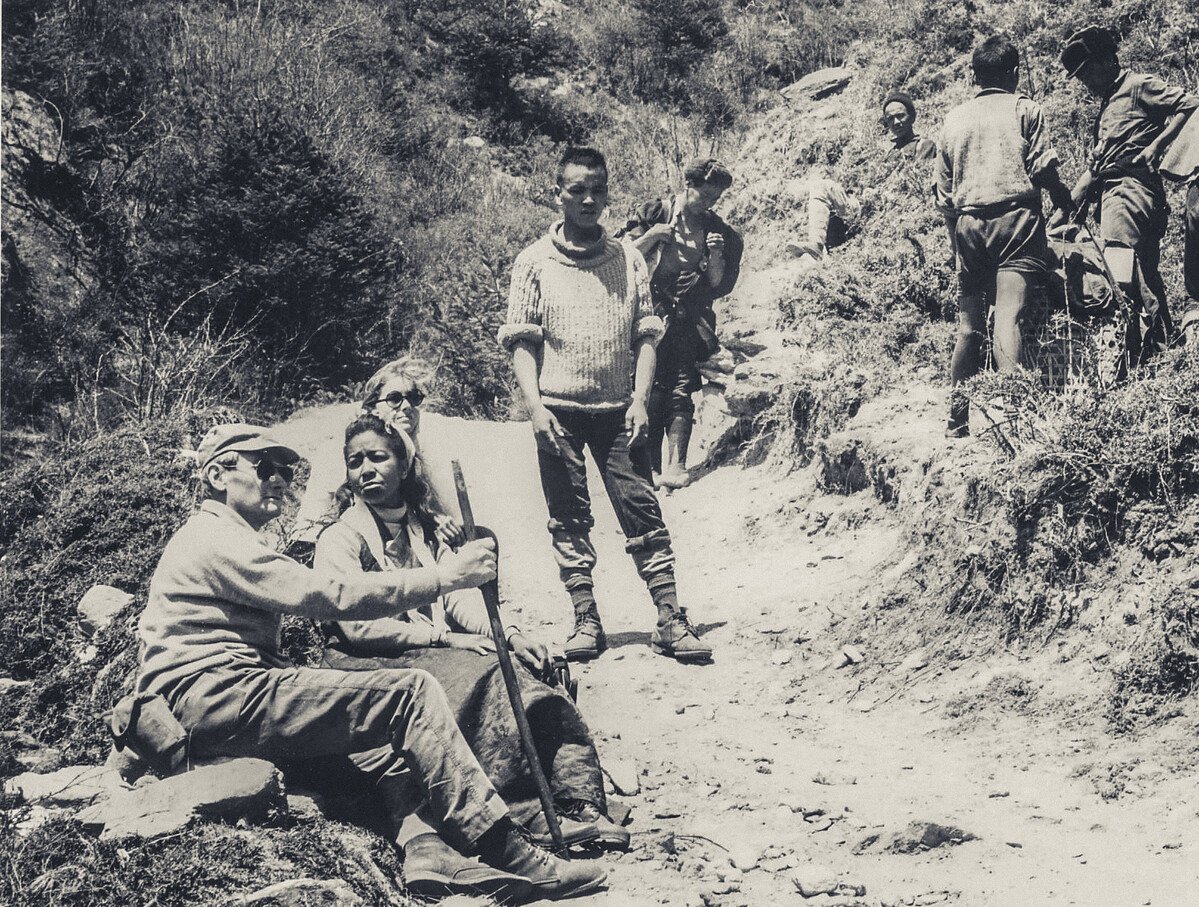
Trek group to Lawudo, Lorenz Prinz, left, with Max Matthews, Judy Weitzner, and rest of the team. Photo courtesy of the Lama Yeshe Wisdom Archive.
Preparations for the trip to Solu Khumbu
Lorenz Prinz had returned to Nepal to complete work on a book of photographs of the Himalayas. He had driven overland from Germany with his assistant in a VW van loaded with darkroom equipment. He rented a small house near where we lived out in the country and set up a dark room. He invited me to come and watch him work a few times and I found the alchemy of photography fascinating. Prinz always wore a jaunty beret. He confided that he had had two brain surgeries to remove tumors. Both times it was predicted that he would never walk again and both times he retaught himself how to crawl and then to walk. He was determined to finish the work on his book. Fortunately, he had experience trekking in the Himalayas so we joined forces and he guided us in our preparations for our trip. Max and Chip and I were going on our Spring break from teaching at Lincoln School, so we couldn’t afford the time it would take to hike all the way up to the Everest Region. Prinz made arrangements for chartering the airplanes. Zina and the Lamas wanted to come too. Lama Zopa had not returned to his birthplace since he was taken to Tibet as a young child. He wanted to see his family and return to his village. Zina had invited her French filmmaker friends to meet them in the mountains and film Zopa’s return to his village.
One of my students at Lincoln School was the daughter of a Canadian consultant to the Royal Air Nepal airlines. The family would occasionally invite me to dinner. He was totally appalled at what he found in Nepal. He told me that even the pilots don’t wear seat belts, there were no functioning control towers, and the airplanes weren’t regularly serviced. He said he was amazed that there weren’t frequent crashes given how they operated. I was quite sobered by this conversation. I then mentioned that Prinz had hired the King’s airplane to fly us to Lukla. I was hoping he would say that the King’s plane was serviced regularly and I shouldn’t worry, but what he said was “That plane can’t fly to Lukla. The Lukla landing strip is too short for it – only 900 feet – your plane needs 1200 feet. You need to have a STOL plane (Short Take-off and Landing). A contract group called Arizona Helicopters has them.” I told him that Prinz had tried and that there were no planes available for the flight up, but they could only come and pick us up. I was worried, but I rationalized the situation by thinking that they wouldn’t send a plane to a place where it couldn’t land. They know better. They wouldn’t sacrifice the King’s airplane for some charter money.
In the days before we left, we all scrambled and scrounged for equipment and food. In those days you did it all yourself. There weren’t even accurate trekking maps, much less jackets, sleeping bags and boots to fit big Western feet. We had schlepped big boots and down jackets in anticipation of trekking. Zina was in charge of equipping the Lamas. Even though Max wanted to come along, she seemed to pay little attention to what it entailed. Max needed to find some sort of outdoor clothing. She was an elegant dresser and I had never seen her in pants or “practical” shoes. Fortunately, Prinz had plenty of experience and guided us through the preparations.
Flight to Lukla
The morning of the flight Max made her appearance in a long brocade chuba (Tibetan dress), a silk blouse and beautiful flowers pinned in her hair. I couldn’t believe that she intended to trek in that outfit. Yet Max was oblivious to my reservations about her outfit and lifted her skirt to show me that she had managed to purchase some Nepalese army boots. These were her gesture to mountain gear. Other than that, style always trumped functional clothing. Prinz and his assistant arrived with camera gear slung around their necks. Zina arrived with Lama Yeshe and Lama Zopa. They wore their robes: no sturdy shoes, no jackets, no hats, nothing else. I was upset with Zina for not taking better care of them, but they seemed content with what they had. I always seemed to be playing the role of the practical pig with my very interesting, but totally impractical friends.
While we waited for the pilot to arrive, the Nepalese were loading the plane with all kinds of things, nothing belonging to us. They were filling the aisles up with packages. When I saw them loading a child’s tricycle, I knew that it wasn’t ours. Prinz finally stopped them from putting any more cargo in the plane arguing that we were paying for the plane and it should be reserved for our stuff. Thank God he stopped them when he did, because I am sure we would have crashed with any more weight.
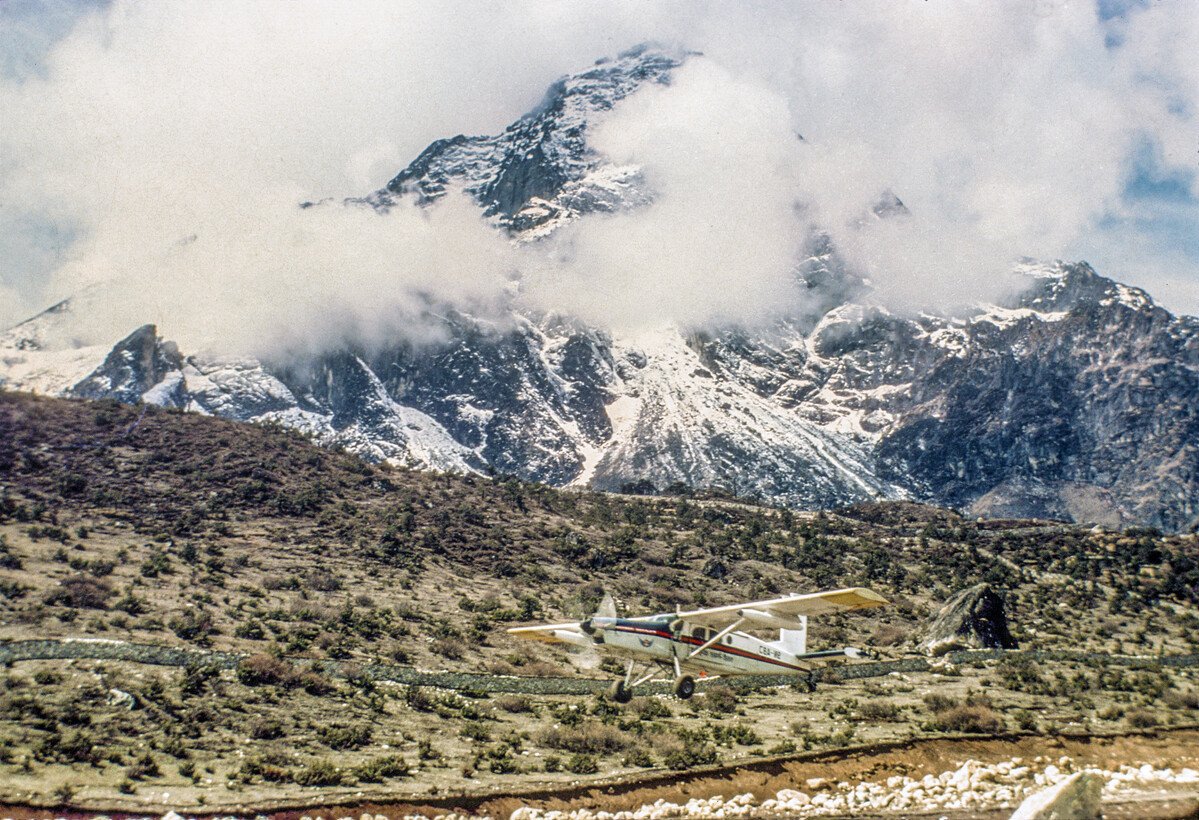
Plane flying out of Lukla airport, 1974. Photo courtesy of Lama Yeshe Wisdom Archive.
Finally, the pilot turned up. He was not the regular pilot. The regular pilot was sick, he explained. The replacement pilot had never flown this route before, but he was willing to give it a try. The problems with this flight were mounding up. Had I been a little more savvy, I would have proposed we cancel the whole idea, but we had all planned this for so long. I was thinking “Surely, they wouldn’t have someone who didn’t know the route fly us in a plane that couldn’t land where we were going, that was also overloaded with cargo, would they?” Well, the answer to that question was…”They would!”
We boarded, some of us scrambling over the cargo in the aisle. We chose seats, which had no seat belts, just as the Canadian had predicted. We tied ourselves down with rope and bungee cords. (Good old bungee cords…I never travel without them. They have saved my bacon more than once). We took off, circling to gain altitude and marveling at the view of Bodhanath and the hilltop that would become known as Kopan from the air. The Lamas were seated in the rear seats. When I looked back at them, they were smiling, but I noticed both of them clicking away on their malas, and thought they might be nervous on their first airplane ride. The reverie of the aerial views of villages, temples and magnificent landscape was abruptly replaced with sheer terror as we hit TURBULENCE. This was not the rocking and rolling that we had experienced in big airplanes. Our plane was buffeted around so hard, it felt like it would break apart! Sometimes we would be blown sideways. I swear our wing was only feet away from the mountainsides. Sometimes we would drop downwards, lifting my heart to my throat. I was pretty sure this would be my last flight. Prinz’s assistant fainted dead away ending up in the aisle. My worry about her took my attention away from our impending disaster for a short time and I was grateful for the distraction.
The pilot looked back at us occasionally after some near miss and rather than inspiring me with steely-eyed confidence he would shrug his shoulders and give us a “what me worry?” look, like what did you expect from someone who has not flown this route before? I looked back at the Lamas again, and prayed that they could keep us aloft with whatever power they had. Finally we started banking and circling around over a deep valley. I looked out and way, way down I saw there was a cleared field, a landing strip. It must be Lukla.
The problem was that we couldn’t approach the strip directly as the plane was too big. We had to spiral around and down with mountains close to our wing tips. We were all terrified, and then sick and nauseous as we descended in circles and finally set down on the runway, hitting and bouncing. The problem was that if the plane undershot the runway, we would have crashed into a mountain.
But, oh no, we had overshot the already too short runway, and we were racing toward the mountain at the other end. “Why didn’t I listen to the Canadian?” I was thinking. “He was right, we can never stop in time”. I braced myself for the crash into the mountain, when suddenly the pilot hung a U-turn throwing us all to the side of the plane. I was sure we would roll over, but, no, we were headed back down the runway, the way we had come. He brought the plane to a stop and we piled out as quickly as possible. Most of us just laid on the ground, hugging the earth, grateful to be alive.
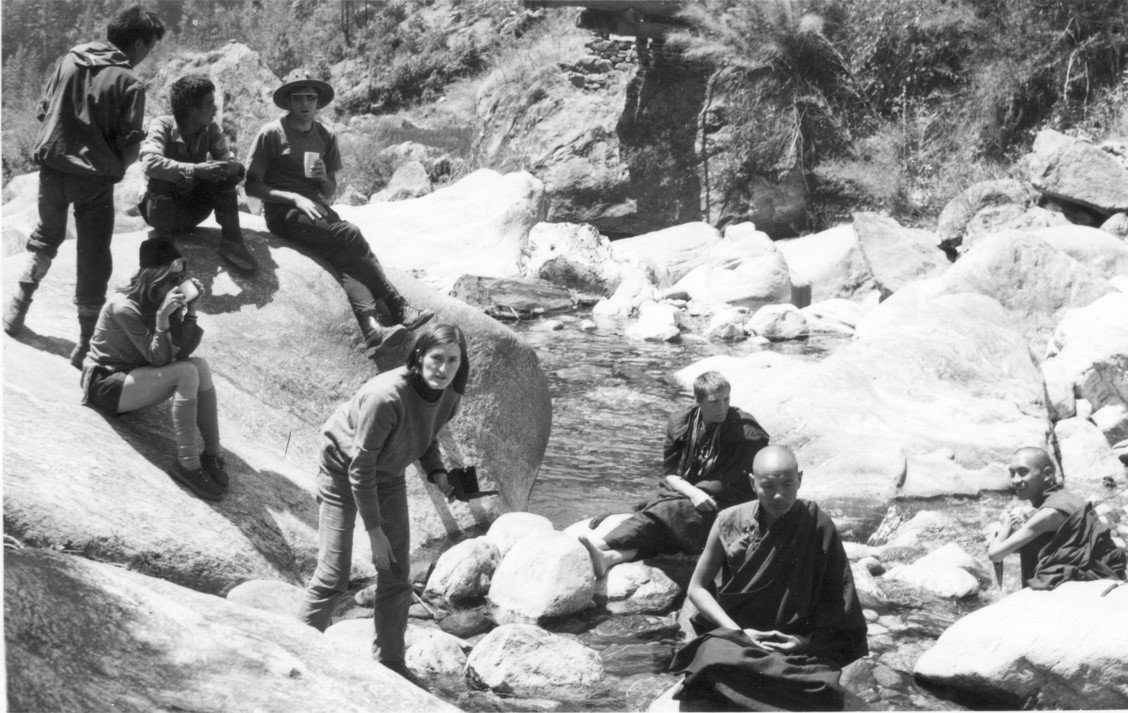
The treking group stops by a river in Kusum on the way to Phagding. The party included Lama Yeshe, Lama Zopa Rinpoche, Max Mathews, Zina Rachevsky, Jacqueline Fagan (a New Zealander who had been at Villa Altomont), Judy Weitzner and her husband, Chip Weitzner. Photo donated by Judy Weitzner to the Lama Yeshe Wisdom Archive.
Some Sherpas approached us wanting jobs as porters and Prinz hired some of them to carry our gear for the trek. They loaded our things into large baskets which they carried on their backs supported by a strap around their forehead. We regrouped at a tea house in Lukla and then began a really pleasant, fairly flat walk up a beautiful valley. I was lulled into thinking that trekking wasn’t so tough after all and that I had been over-worried about preparations.
We spent the night in a Sherpa home, a cousin of our guide, Ang Dorje. I had to crouch to get through the very low doorway. I was ushered inside and offered a seat along the wall. Slowly patterns of white dots began dancing before my eyes. At first I couldn’t figure out whether it was a visual hallucination, but as my eyes became used to the dark I could see that they were drawn on the black walls and shelves. Next I began to make out the glint of handmade metal pots arranged in order of size. As they came into view I marveled at their beauty and craftsmanship. In Kathmandu they sold ugly aluminum pots. These Sherpa pots were amazing. There was a hearth in the corner where the woman of the house presided over the fire and the cooking. The few shafts of light revealed a smoke filled room. I looked up above the fire for a chimney. There was none–just a small opening. All the rafters were thick with black soot which had a dark iridescence when it caught the light. It must have taken decades to build this thick layer. I thought to myself, “In Nepal, they haven’t invented the chimney, yet”.
Later, when Prinz arrived, he failed to duck low enough as he entered, and hit his head on the overhead beam. He was reeling at the blow. When I went to help, he explained the problem was that when he had had brain surgery for a tumor on his brain before coming to Nepal, the doctors had not replaced the section of skull that had been removed. His beret disguised the fact that there was only skin and no skull . He had taken a direct blow to the brain. I was worried about him, but he was stoic and determined to go on. Really, there was no other choice.
That evening, we sat around the fire with the family. I was already beginning to fall in love with the kind and generous Sherpas. Usually, there was someone sitting and spinning wool. Someone else might be weaving on a loom in the corner, or outside in the sunshine. In the US I had been a part of the counter culture which valued self-sufficiency and hand-crafted items. Many of my friends were “back to the land hippies”, experimenting with gardening, carpentry and alternative forms of society. We wanted to rely less on manufactured goods. We wanted to live in communities rather than the isolated nuclear family model of the previous generation. Sherpa society seemed to be living our ideal. I was smitten.
For dinner, our cook prepared some of the food we had brought along. Our Sherpa mother, (Ama) cooked a huge pot of small potatoes. I watched in fascination as the family pinched the cooked potatoes, removing the skin with one gesture and popped the whole peeled potato into their mouths. They shared some potatoes with us and I tried, in vain, to master their technique. I got nowhere and had to painstakingly peel my potatoes in little strips. To this day, I think of the Sherpas when I cook potatoes and wish I knew their magic peeling mudra.
I thought that this was the perfect time to offer my gift. I had heard about the problem of goiters in the mountains. I also knew that salt was a valuable commodity and Sherpas had been involved in the salt trade with Tibet. The American commissary stocked packages of miniature Leslie salt shakers–iodized, of course. I had purchased several to offer to our hosts along the way. Thinking the family would enjoy the salt on their potatoes. I showed them how to twist the lid and sprinkle the salt out. Once they saw that it was salt, they opened the top to the pouring spout, held the shaker above their open mouths, poured, and swallowed the contents in one gulp. Apparently, they really liked salt, but not exactly as a condiment.
The next morning I saw a beautiful woman with a huge goiter. “Why couldn’t USAID do something practical that would change peoples lives for a small investment in iodized salt,” I thought. Next I saw an elderly woman lying on the ground at the side of the path. She was too weak to sit up and was obviously quite ill. Nonetheless, she put her hands together in a namaste greeting and flashed a big smile. I summoned our guide to translate. I said that I was concerned about her and I thought she should go to the hospital. She protested that she couldn’t walk and she didn’t want to go. Besides, she needed to look after her grandchildren. Apparently, someone would carry her outside each morning so she could watch the kids. I told her family that I would hire someone to carry her to the hospital, but she said “no” to that, too. I reluctantly left her behind, but reflected on the fact that despite her extreme disability, she had a valued job to do and that it mattered more to her than the possibility of getting medical help. She was supremely calm and content with things as they were.
The next Himalayan moment came when it was time to cross the river on what the Sherpas would call a bridge. What I saw were some ropes suspended across the river with some boards cradled along the center. There were gaps between some of the boards. I walked a few steps out and discovered that my footsteps caused an undulating rhythm which combined with the swaying made calculating where I put my foot down very challenging. One misstep, and it was a long way down to the river. I rejected offers of help because I knew I didn’t want anyone else on the “bridge” with me. When someone else was walking on the boards, they set up their own unpredictable undulation, making it even more difficult to gauge and direct my next step. The Sherpas noticed my trepidation and told me that when Sir Edmund Hillary built bridges, they stayed in place, but when Sherpas built bridges (here they made a swooping gesture) they washed down the river. Their light-hearted humor only made things worse for me. Holding the waist high rope as I went, I made it across. I failed to inquire whether I had crossed a Sherpa bridge or a Hillary bridge,
We meandered along the river on an easy trail for quite awhile. We were strung quite far apart down the trail. That day, I began to realize that one of the secrets to trekking was to walk at my own pace – not trying to keep up or slow down to walk with someone else. Establishing a rhythm of breathing and walking and paying attention made all the difference.
Max and I were together, moving at the same speed. Suddenly the trail seemed to come to a dead end right at the base of a mountain. There was a pathway heading upward quite steeply, but I couldn’t imagine that it was our trail. I assured Max that we did not have to climb, while I looked around for the proper route, but couldn’t find it. We decided to wait until the Sherpas came along to show us the way. When they came, they pointed upward at the very steep trail. Yes, that was the trail and we were going to have to walk up it. I had completely convinced myself and Max that the upward trail couldn’t possibly be the right one. We had no choice but to start climbing. Not only was it “up”, it was 2,000 feet up, taking us to over 11,000 feet. Without trekking guides or maps, we had no idea we were ascending so quickly, without acclimatizing. Later on much more was known about altitude sickness.
Lama Yeshe and Lama Zopa helped us along. Whenever we needed a boost, Lama seemed to make an appearance to help. Several times when he offered a hand, I wondered, “How did he get in front of us? I thought for sure he was behind.”

Lama Zopa Rinpoche (left) and Lama Yeshe at Thangme, during the first trek to Lawudo in 1969. Photo by Georges Luneau.
I was nearing utter exhaustion when I came upon a Sherpa serving the Lamas hot tea at the side of the trail. He had hiked down from Lama Zopa’s village to greet him. We all sat around and had tea on the side of the mountain. Slowly, I was getting the picture that Lama Zopa was an important person and that the Sherpas were very happy that he was coming to visit. I heard them relay the message up the trail. “Lama’s coming. Lama’s coming” They took the trouble to walk for a day to give the Lamas tea. . I had thought that we were bringing the Lamas along on our trek, but I was beginning to realize that we were beneficiaries of being in their company. Another thing was becoming clear to me, the Sherpas had their own method of tracking people in the mountains. When you met someone on the trail they would ask “where are you going” and “where are you coming from.” Lama Zopa’s arrival had already been telegraphed to his village by this word of mouth method.
When we reached Namche Bazaar, Max and I just sat down on the trail overlooking the famous market town of the Himalayas. I was envying the big birds who were effortlessly gliding on the updrafts. I wanted to trade places with them and soar rather than trudge along. I was tired and crabby. I needed to muster the energy to walk to the guesthouse where we would spend the night. It had turned cold and I was bundled up in my down jacket, but still freezing. Lama Yeshe came along and sat down next to us, admiring the view. Lama held my cold hands in his, trying to warm them up. Suddenly, I was jarred out of my self-pity and noticed what was going on. Here I was, dressed in layers and down and still cold. Lama had his sleeveless shirt and light robes, yet he was warm as toast and trying to take care of me. I asked him, “Lama, how can you do this? How is it that you are warm and I am cold even in my down jacket?” He said, “Oh, it is easy dear. In Tibet we learn this meditation. It keeps us warm. And it is very necessary in cold weather!” Having been plagued by the cold my whole life, I thought, whatever it is, I want to learn it. (Later, when I read Lama Govinda’s “Way of the White Clouds” I would understand that he was talking about Tumo meditation. He did teach it in the last teaching I would receive from him at Vajrapani when he taught “The Six Yogas of Naropa”.)
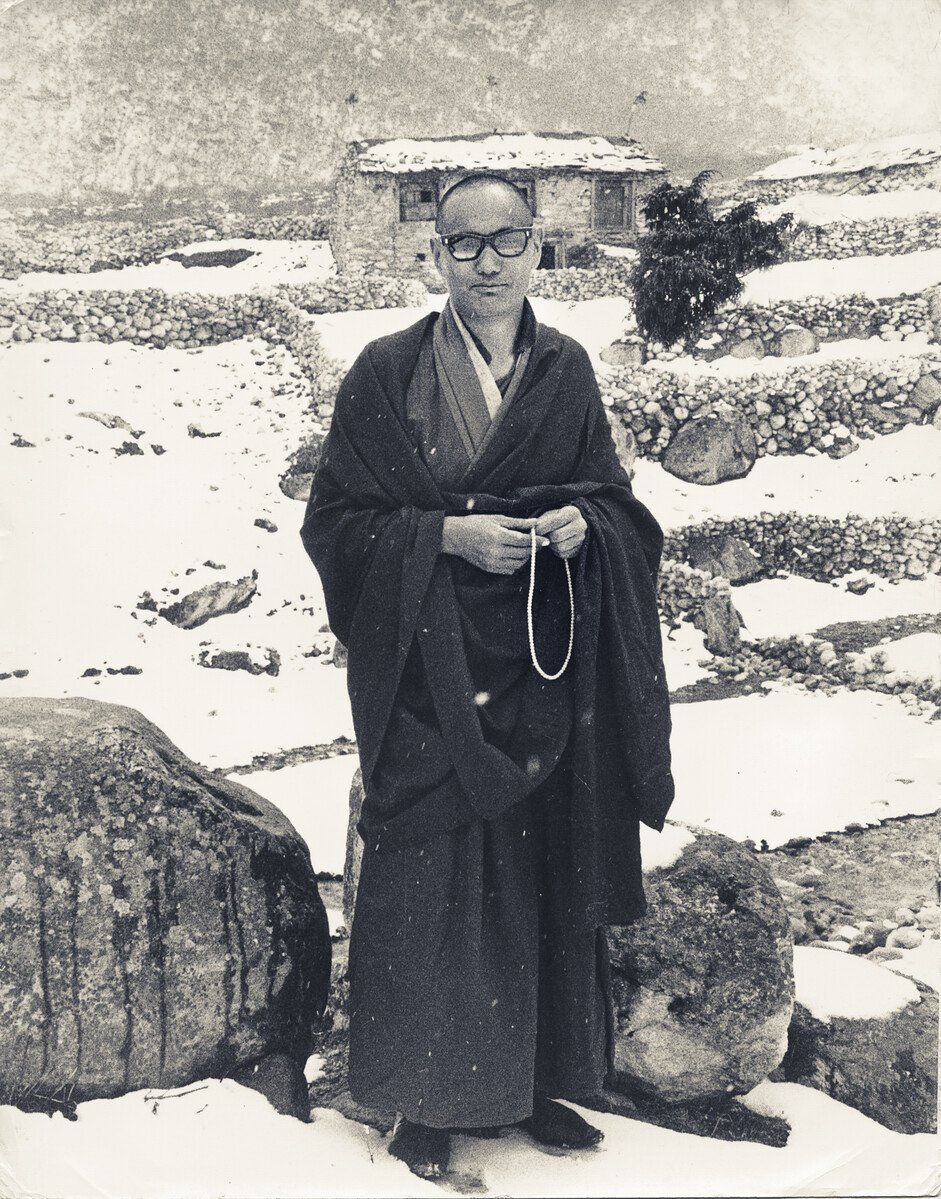
Lama Yeshe at Thangme, Nepal, during the first trek to Lawudo, Spring of 1969. Photo by Georges Luneau.
The next thing that happened is really hard to believe, but, I swear it happened. Lama was carrying a canteen with cold tea. (Each night, we would fill our canteens with the leftover tea from the evening before to drink during the day.) He asked if I would like something to drink. I said, “yes, I would, but not tea”. “What would you like, dear?”, he asked. I grumpily replied, “a Coca-cola” At the time there was no Coke in Nepal and there was no way he could have even known what I was talking about. The remark was meant as a joke for Max. He poured some liquid out of the canteen and gave it to Max. Max said, ”Look, Judy, it’s Coca Cola. Taste it.” I held it up and looked. It was carbonated. Bubbles were moving up the side of the cup. I tasted it. It was Coke. We all laughed and laughed and I completely forgot about my exhaustion and my bad mood. It was there on that mountainside that I realized that Lama Yeshe was totally amazing and powerful.
On our first night in Namche Bazaar we stayed in two different guest houses. Zina (Rachevsky) and Jacqueline and the Lamas were a few houses away from us. They met the French filmmakers there. When Prinz arrived, he was walking slowly with a stick. He had caught a cold and it was going into his lungs. Actually, he clarified, it was going into his one lung. The other one had been removed. First, no skull, then no lung! Should this man be in the Himalayas? I wondered. Fortunately, we found out that there was a small hospital established by Sir Edmund Hillary not far away. We planned to take him there the next day.
Our party split up the next morning. Zina, Jacqueline, and the Lamas headed toward Lawudo. Lama Zopa would return to his birthplace for the first time since he was carried over the mountains as a small child to go to Tibet for his education. At the time Lawudo was restricted and you needed a special permit to go there. The rest of us headed to Khunde, which was on the way to our destination, Tengboche Monastery. We walked along a high ridge spotting a beautiful iridescent bird along the way. It was Nepal’s national bird. It was the only time I saw the bird except on postage stamps. What a country! A flag with the sun and moon, a national bird that was beyond belief beautiful, and…the Himalayas!!! I was transferring my allegiance to this remarkable place.
The Hillary hospital was staffed by a young couple, doctors from New Zealand. They examined Prinz and diagnosed pneumonia. He would have to stay there. That night we stayed in the beautiful gompa room of another Sherpa home in the village. We slept in their gompa facing an elaborately carved altar with many statues and texts. I felt privileged to sleep in this holy place. Through the small window we could see the sacred mountain, Ama Dablam. When we awoke the next morning and looked out, the landscape had been transformed with a covering of snow. We were going to have to take a lay over day and wait for the snow to melt.
Fortunately this would allow a visit for some of us to see the famous Yeti skull which is housed in Khumjung monastery. I was told by some Sherpas that there were actually three kinds of Yetis – small ones who are vegetarians, medium-sized who eat small animals and big ones who eat yaks and people.
Max (Matthews) and I stayed in the gompa room most of that day. We spent the time in a deep philosophical discussion about the meaning and purpose of our lives. I was reading Alan Watts’ book, “East meets West” which prompted a discussion about Eastern and Western philosophy and our good fortune in meeting the Lamas. It was a magical time deeply imprinted on my mind…looking up at the benevolent gaze of the Buddhas, wondering about the contents of all those beautiful silk-wrapped books. Max and I truly became “Soul Sisters” that day. I felt it was a turning point for both of us. Max wanted to change the direction of her life. Till now my study of Eastern philosophy had been merely an intellectual pursuit. I felt my heart opening to a deeper level.
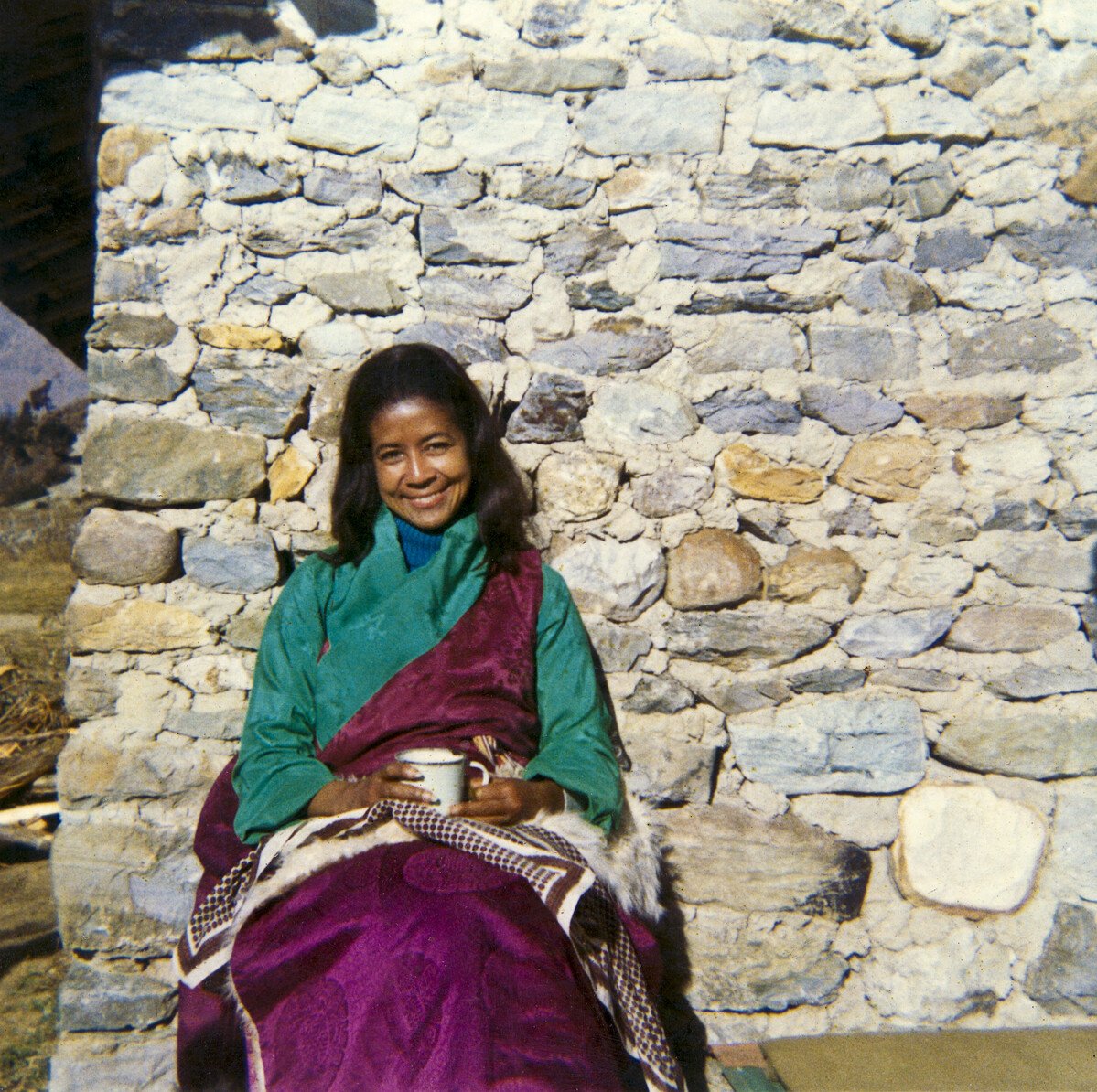
Max Mathews in a photo from the first trek to Lawudo Retreat Center in Nepal, spring of 1969. Photo courtesy of Lama Yeshe Wisdom Archive.
We were up early the next morning. We knew it was going to be a hard day. When we reached a view point above the valley, the Sherpas pointed out where we would walk: way, way, down to the river and way, way, up the other side. I thought, “no way am I going to be able to walk that far in a day.” Every muscle in my body was sore from the previous day’s walk, but on we went. That day I really began to understand the workings of the human body – things I had taken for granted before – the need we have for oxygen and food for fuel. When we got down to the river, I was about spent. I had discovered that going down is not really easier than going up and that “Sahib’s knee” (the sore knee that inexperienced trekkers get) really happens on the way down. We had a few bars of pemican with us and I ate one. I could feel the renewed energy from the food. It’s funny, but I had never associated eating much with fueling the body for work.
I started up the other side, quite slowly. We were going to a higher altitude than we had been before. Gradually, I became aware that I was running out of oxygen, another thing I had always taken for granted. I had to take several breaths to get enough oxygen to take a few steps. I was moving so slowly that one of the Sherpas came back to help me. He wanted to pull me along with a belt. I didn’t want to move any faster than I was, because each step up meant less oxygen. We compromised finally, with him giving me a bit of a hand, but progressing more slowly than he would have liked. When I finally made the top, everyone else was there and had found lodging in a stone hut at the far end of the village. Mt. Everest was straight ahead with the plume of snow that always blows from the top. The Sherpas call it Chomolungma – Mother of the World, which to me is a more fitting appellation. We were surrounded by magnificent peaks. Each seemed to have its own presence, its own emanation. Indeed they are sacred and deserve our deepest respect.
Tengboche monastery was to our left. The view was vast. Gradually, I adapted to the altitude and could actually walk around without huffing and puffing. We spent a couple of nights there, hiking toward Base Camp one day and visiting the monastery for a blessing on the next. In the doorway of Tengboche I noticed that the same “Wheel of Life” drawing was at the entrance as I had seen at Samyeling Monastery near Bodhanath. I was curious about what it meant. It took several years to patch together the meaning of all the symbols in that amazing drawing. Now there is a book about it, but then I learned about it in bits and pieces when I had some time with a monk or a lama.
The way back to the Hillary Hospital was much easier. We were losing altitude rather than gaining, and my stamina had built up to the point where I could get up and walk for the day without too much problem. It was a real breakthrough for me and my body: to know that I could walk as far as I needed to go and that it didn’t matter whether it was up or down, it was all the same. I felt stronger and more in charge of myself than I had for my whole life. There was way more to this trek than what we saw along the way. For me, it was an incredible integration of body, mind and spirit. I knew I had the strength to do what needed to be done.
Prinz was on the porch of the hospital waving and smiling and looking way better. Thank God for antibiotics. Thank God for Sir Edmund Hillary’s kindness. And here was another amazing karmic incident. The doctors excitedly told us that they had an old x-ray machine that had been donated to the hospital. It had never worked and it was so old they had no idea what to do with it. It turned out that Prinz had driven an ambulance during the war and served as a medic. He was totally familiar with this type of machine, and without hesitation, he made the repairs. (Can you imagine – repairing the x-ray machine, so they can look at your lung?) Not long after they had tested it out on him, a Sherpa walked into the hospital who had fallen off a mountain. They used the machine to diagnose the extent of the damage and found multiple fractures, arms, legs, ribs, everywhere. The miracle was that the Sherpa was so muscle-bound that his musculature was holding the broken bones in place. He was his own cast. That is how he could walk in with all of those fractures. We left Prinz and his assistant behind as he needed a few more days of recuperation before getting to work on his book.
When we arrived back at Namche, it was like coming home to a familiar place. At that point, Chip decided he had to try to go to Lawudo. He just took off down the trail without a permit and said he would be back the next morning in time to leave for Lukla and to catch our flight out. He was flying along the trail and right past the guard station. The guards chased him for a while but gave up. He was moving too fast.
Max and I were waiting back in Namche for him to return. I was getting very nervous. We had to leave by a certain time to make it to Lukla to catch our plane back to Kathmandu. Chip came back late. He was so excited about his experience in Lawudo – going to the cave belonging to Lama Zopa’s predecessor and seeing Lama Zopa and Lama Yeshe make themselves at home there. He had helped open the door by wriggling underneath the entrance. The whole village had turned out for the opening of the meditation cave.
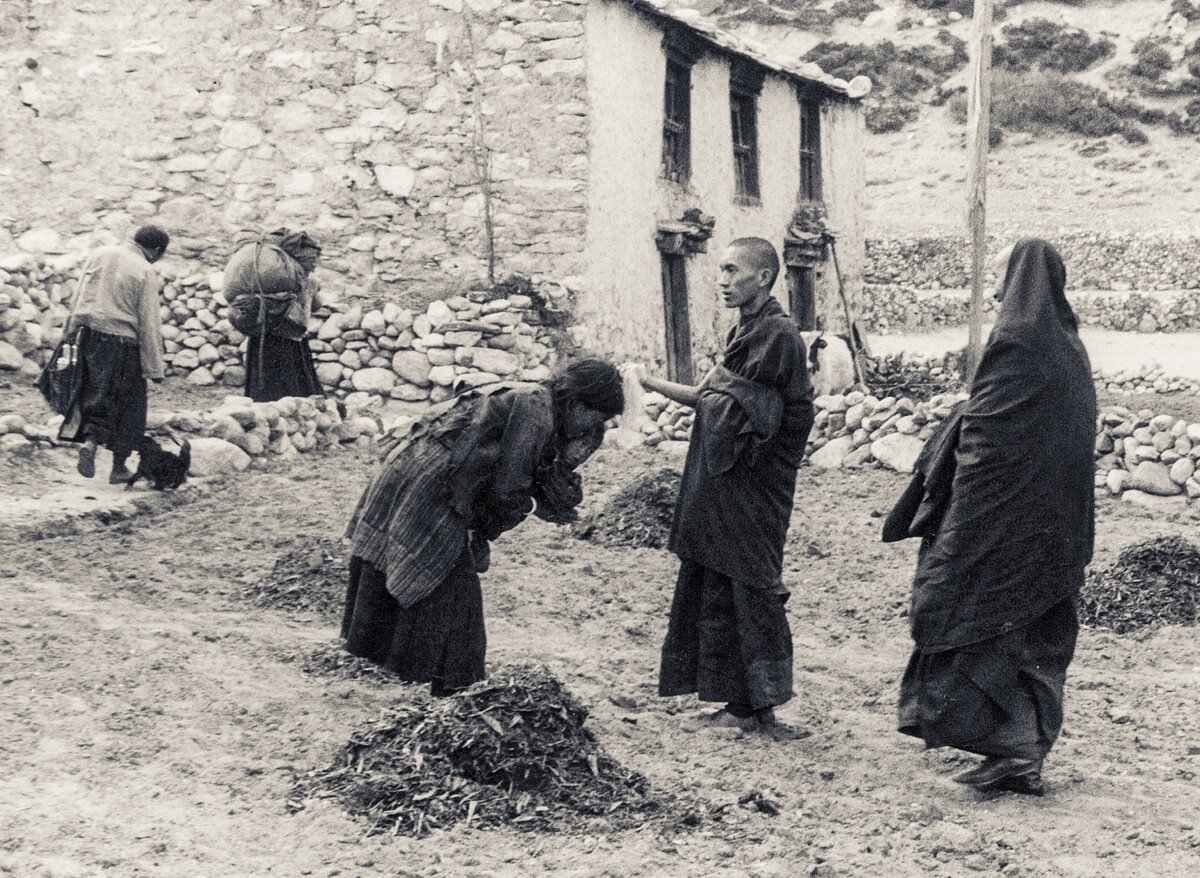
Lama Zopa Rinpoche (center) blesses a mother and child as Lama Yeshe looks on at at Thangme. Photo from the first trek to Lawudo Retreat Center in Nepal, spring of 1969. Photo by Georges Luneau.
Chip carried a note from the Lamas to Max and me. They said that they were going to stay in Lawudo and do some retreat, so we wouldn’t be seeing each other for a while. They also asked if Max and I could work on establishing a school for the children in the Lawudo area. Pieces of the puzzle were coming together. We finally understood that the people of the village had come to Lama Zopa when he was in his previous body, meditating in the cave, and requested that he start a school for their children. There was no school in the area, and, if they wanted an education, children had to be sent to Tibet or down to Kathmandu. The old lama said that he was too old and was going to die soon, but that he would do it for them in his next incarnation. Now, Lama Zopa was back and it was time for fulfilling the promise. Really, this was the first I had heard of promises being made in previous bodies or lifetimes. It was all very far out, but my skeptical mind was relaxing and allowing for possibilities that I would have questioned before.

Lama Zopa Rinpoche artwork, brochure for MEC school at Lawudo, 1969. Image courtesy of Lama Yeshe Wisdom Archive.
At Lukla, we bid farewell to our Sherpa guide, Ang Dorje. I felt so grateful to him for taking good care of us. I wrote a letter of recommendation on a scrap of paper and explained that he should show it to future trekkers to obtain jobs. Many years later, a friend who went trekking told me that they hired a Sherpa who carried a barely readable note from me. It had to be Ang Dorje. I was glad that gesture had served him well.
We waited in Lukla for the Arizona Helicopters plane. There, we were told that the King’s plane had returned on another run the same day we arrived. Maybe they were delivering the cargo that we refused on board. This time the pilot undershot the runway. The landing gear hit the mountainside and the plane crashed. Fortunately, no one was hurt. The plane was later towed by yaks up the runway to Lukla and converted to a Tea house, I heard.
I couldn’t believe how the STOL plane landed. It just flew directly in, without all the spiraling downward that we had done on our arrival. It hit the runway and stopped half-way up – no U-turn needed. The steely-eyed rough neck pilot got out, cussing and swearing. He was mad because we had a big Sherpa pot with us and it would put us overweight. We begged to take the pot with us, but to get the weight down, he dumped some fuel. He knew what he was doing, but the terror on the way back to Kathmandu, was watching the fuel gage tip toward zero as he swore at us and told us that if we ran out of fuel it was our fault for insisting on bringing the big copper pot.
Max, Chip and I returned to teaching and I began to ponder how we might start a school in the High Himalayas.
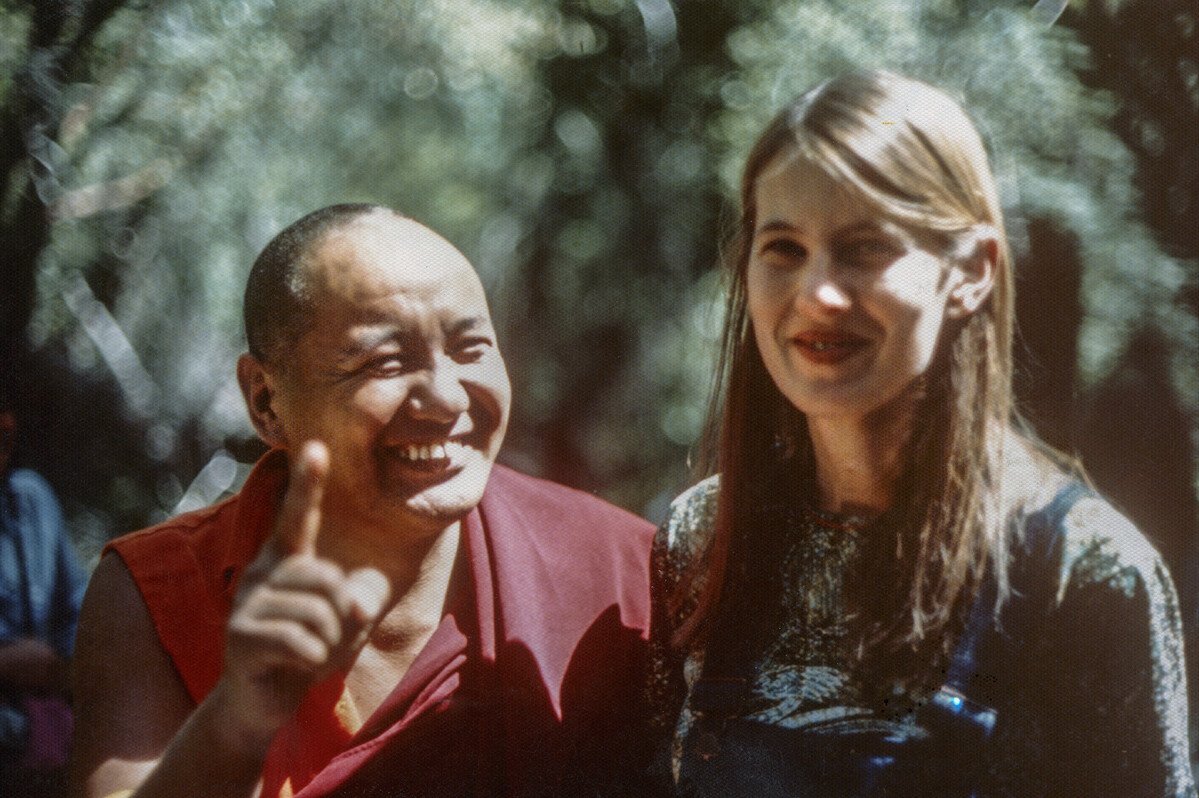
Lama Yeshe and Judy Weitzner on the land of Vajrapani Institute, CA, 1977. Photo courtesy of Lama Yeshe Wisdom Archive.
Please consider subscribing to the Lawudo newsletter which is published four times each year on the major holy days. For more information about Lawudo Gompa and Retreat Center, please visit the Lawudo Gompa website. You can also follow Lawudo on Facebook.
FPMT.org brings you news of Lama Zopa Rinpoche and of activities, teachings, and events from over 150 FPMT centers, projects, and services around the globe. If you like what you read, consider becoming a Friends of FPMT member, which supports our work.
- Tagged: lawudo, road to kopan, ven. margaret mcandrew
25
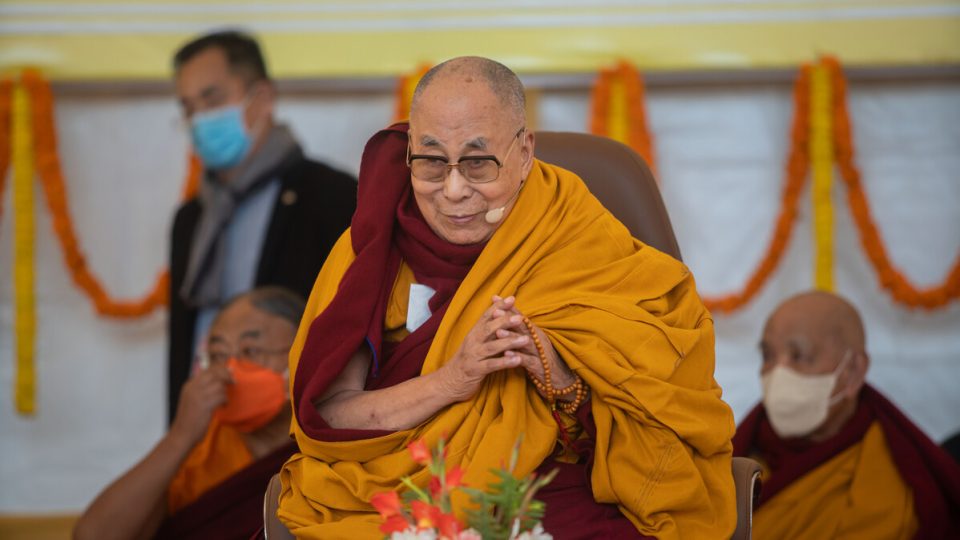
His Holiness the Dalai Lama on the occasion of the laying the foundation stone for The Dalai Lama Centre for Tibetan and Indian Ancient Wisdom in Bodhgaya, India, January 3, 2023. Photo by Ven. Lobsang Sherab.
On a wintry morning of January 3, 2023, His Holiness the Dalai Lama, despite suffering from a bad cold, presided over the foundation stone laying ceremony for his new center in Bodhgaya, India, The Dalai Lama Centre for Tibetan and Indian Ancient Wisdom.
Several thousand attendees, both Central and State Government ministers, Tibetan officials from The Dalai Lama Trust, FPMT Spiritual Director Lama Zopa Rinpoche, CEO Ven. Roger Kunsang, as well as other FPMT organization and Maitreya Project members were present. This was a momentous event, the impact of which cannot be overstated.
This center is being built on 30 acres of land which belonged to the Maitreya Project. In 2020, Lama Zopa Rinpoche offered this land to His Holiness, after being asked if he would consider doing so by the previous Prime Minister of the Central Tibetan Administration’s government-in-exile, Lobsang Sangye, and delegates from His Holiness’s office. Rinpoche happily accepted to make this offering to help actualize His Holiness’s wish to build an international institute promoting human values of kindness and compassion, in this area so deeply blessed with Buddhism.
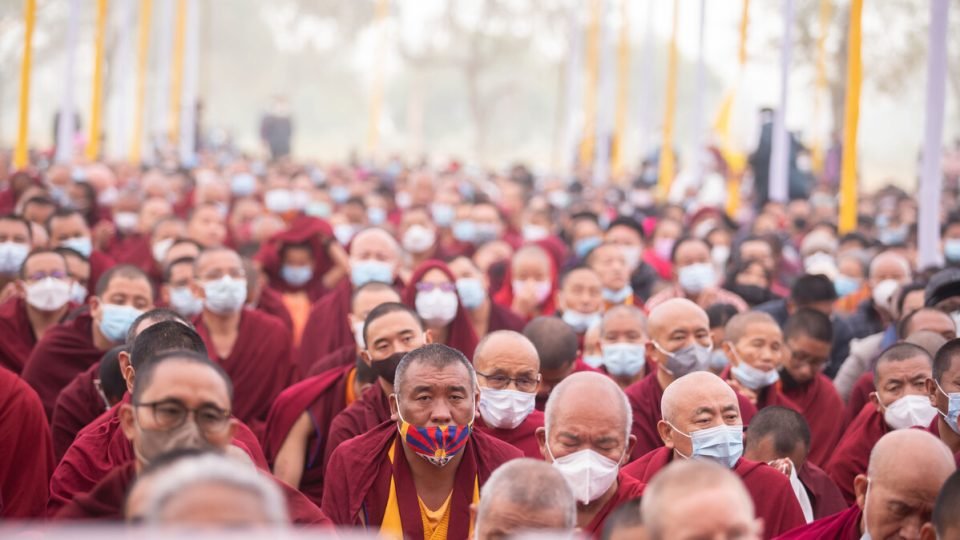
Crowd attending the laying of the foundation stone ceremony for The Dalai Lama Centre for Tibetan and Indian Ancient Wisdom in Bodhgaya, India, January 3, 2023. Photo by Ven. Lobsang Sherab.
Interim director of the project, Tempa Tsering, opened the ceremony with a warm greeting to everyone present and welcomed the special guests.
“The center is His Holiness the Dalai Lama’s vision,” Mr. Tsering explained. “A vision to make this world more peaceful, to make human beings more compassionate, caring, and peaceful, so that there will be genuine peace and happiness in the world. To complete this global objective of genuine happiness, His Holiness firmly believes that the ancient Indian knowledge of the workings of the mind and emotions, as well as ancient Indian methods of mental training, merging with modern science and technology, have much potential for contributing to a safer, happier, more harmonious world for everyone. This is His Holiness’s tribute to the world, promoting ancient Indian wisdom. And this is also His Holiness’s contribution to the wellbeing of humanity.”
This project will be jointly funded by the His Holiness the Dalai Lama’s Trust, as well as the state government and central government.
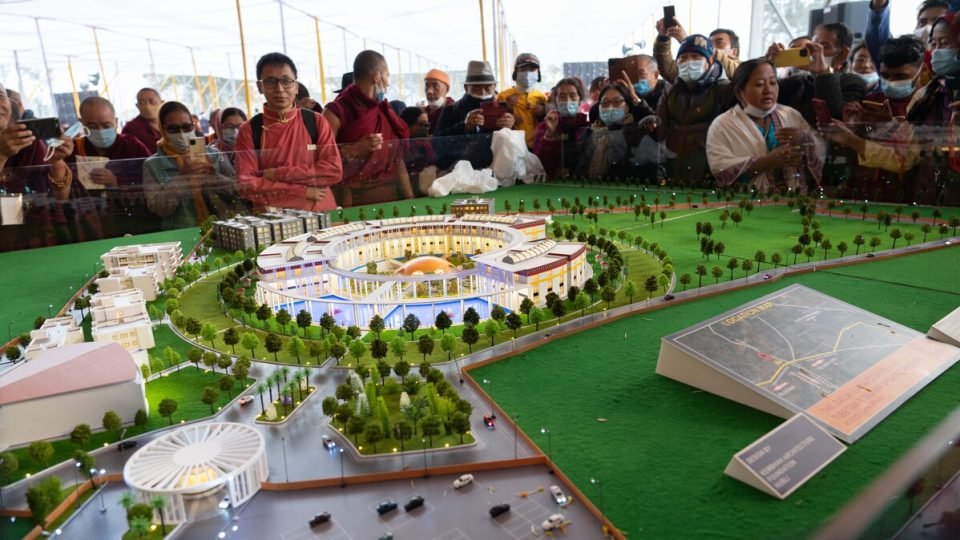
The model for The Dalai Lama Centre for Tibetan and Indian Ancient Wisdom in Bodhgaya, India, January 3, 2023. The credit for this aesthetically designed campus goes to a family of architects from Karnataka, who have tried to synthesize the Indian, Tibetan, and Greek architectural forms to draft this monumental structure. Photo by Ven. Lobsang Sherab.
“We are most grateful both to the central government, and to the Bihar state government for the consistent support and generous assistance we continue to receive,” Tempa Tsering shared. “And also for the support of Maitreya Project and Lama Zopa Rinpoche in form of 30 acres of land. It is envisioned that His Holiness’s Centre for Tibetan and Ancient Indian Wisdom will be a renowned learning center of its kind, open to everyone, offering participants and visitors the opportunity to learn, to awaken their potential to help solve problems and to heal. We would like to urge everyone to please extend your support so that His Holiness the Dalai Lama’s vision for a more peaceful, compassionate world is realized.”
Kiren Rijiju, Minister for Law and Justice in the Central Government, addressed those gathered. “His Holiness has made India his home and has committed himself to helping to revive awareness of ancient Indian wisdom,” he said. “People from around the world come to India to pay their respects to him. His Holiness refers to India as the guru and Tibetans as the students, but I say that it is he, an apostle of peace, who is the guru to world. On behalf of the people and government of India I express gratitude to him. It’s a privilege for us to have him among us here in India.
“His Holiness states that the wisdom of Nalanda nurtured by such masters as Nagarjuna, Aryadeva and Chandrakirti, a tradition grounded in reason and logic, was kept alive in Tibet. It was concerned less with religion and more with a science of the mind. A center to study along these lines is being established and people from around the world will be able to come and study here.
“The Government of India is committed in turn to supporting this center, which will encourage us to look within. The Centre will be a world-class institution, a gift to humanity, where it will be possible to discover the link between peace of mind and world peace.”
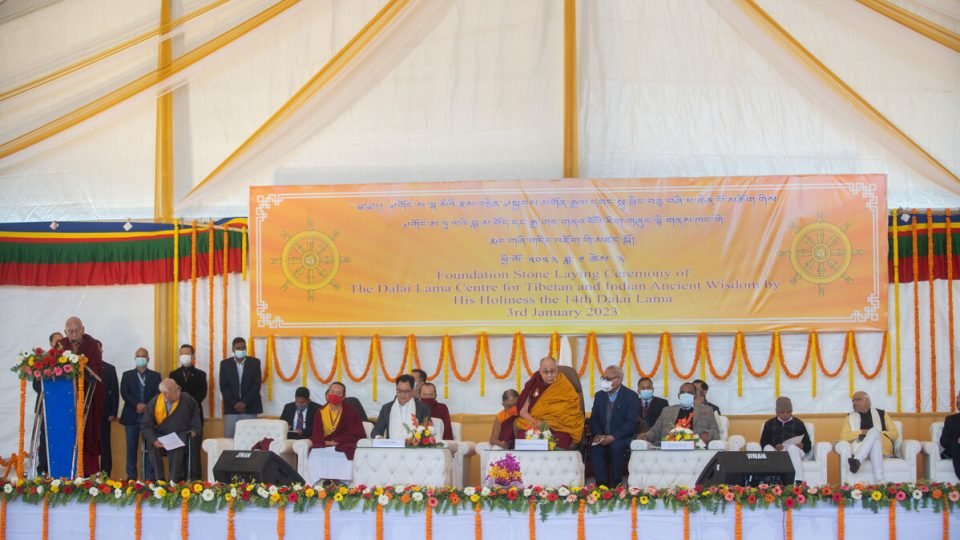
Presenters offered greetings and messages of support to the crowd on the occasion of the laying the foundation stone for The Dalai Lama Centre for Tibetan and Indian Ancient Wisdom in Bodhgaya, India, January 3, 2023. Photo by Ven. Lobsang Sherab.
His Holiness gave a beautiful teaching on cultivating warm-heartedness as the path to happiness, while thanking everyone in attendance including the state and central government, leaders of different religious traditions and within Tibetan Buddhist traditions, and also all the monks and monastics who are gathered.
“Today all of us are gathered here at this sacred and sublime place, Bodhgaya. Whether we are believers in a religion or not it doesn’t matter. We are all gathered here in admiration of the Buddha, and the Buddha’s teaching is very important for bringing about peace in the world,” His Holiness said at the start of his welcome.
“Buddhadharma is basically about the practice of compassion and non-violence and I would like to thank everyone gathered here with this positive state of mind of respect and admiration to the Buddha. The Buddhadharma teaches how to bring about happiness, peace, and support in the world, to bring about happiness to sentient beings and overcome suffering. To achieve this aim we cannot just have wishful thinking that we may have happiness and that suffering will go away, we need to look at the cause of suffering and the cause of our happiness. The cause of suffering is basically our destructive emotions and our self-cherishing attitude—selfishness. To bring about peace in the world, and within ourselves, you need to cultivate a good heart and even if you may be a non-believer, you need to cultivate that mental peace within yourself so that you can share it with others. Master Shantideva says all happiness and joy in the world comes from wishing others to be happy, and all suffering in the world comes from wishing oneself to be happy. So it’s a selfish attitude that brings suffering. Look at the difference between ourselves, who remain like this in samsara, and then look at the Buddha who has become enlightened because of cherishing others over himself.”
“Our daily practice should be warm-heartedness,” His Holiness stressed. “Thinking of the wellbeing of others and a sense of bodhicitta, an altruistic spirit of enlightenment. When we engage in this practice of bodhicitta, we should do so realistically by understanding what would bring about wellbeing and happiness for others, by understanding through your wisdom and analyzing the situation and reality of things. And then, use that understanding and insight along with bodhicitta to serve others. We should all try to do that in our day to day life.”
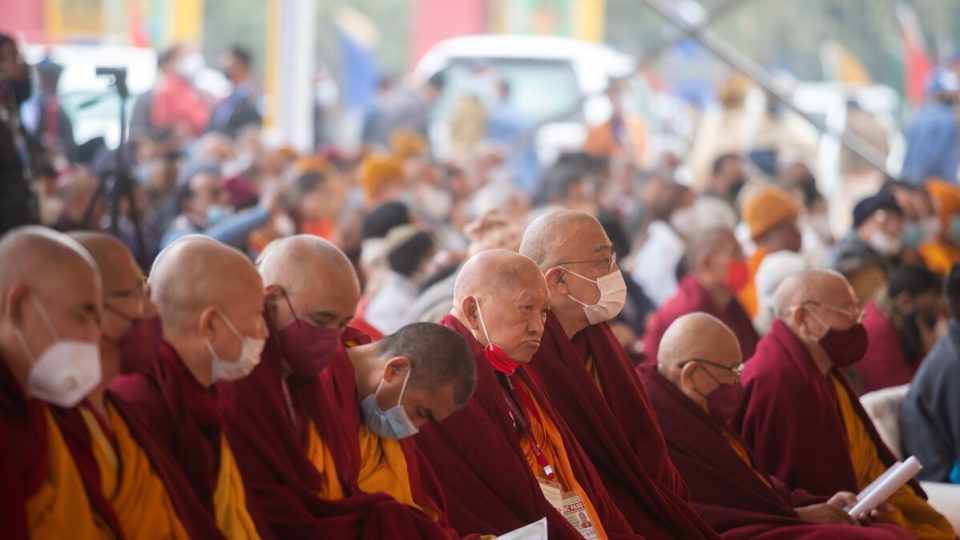
Lama Zopa Rinpoche and others attending the laying of the foundation stone for The Dalai Lama Centre for Tibetan and Indian Ancient Wisdom in Bodhgaya, India, January 3, 2023. Photo by Ven. Lobsang Sherab.
From January 4-5, selected participants, including Lama Zopa Rinpoche on January 4, discussed the content of the intended curriculum in great detail as well as discussion on setting up a library and museum on the grounds. Courses will teach ancient Indian philosophy, psychology, logic, and dialectics. Additionally, The Four Commitments, Mind and Life dialogues and research, Meditation, Mind Training and Emotional Hygiene will be central components of the study program.
Dr. Renuka Singh, director, Tushita Mahayana Meditation Centre, Delhi, was present for this ceremony and shared, “I rejoice that through this endeavor the soul of India’s culture and Tibetan philosophical legacy can continue, safely preserved in the Land of the Snows. During this function there was a melody of new order and radiance for our world, weaving a promise of ancient wisdom and plentitude of one’s heart and consciousness.”
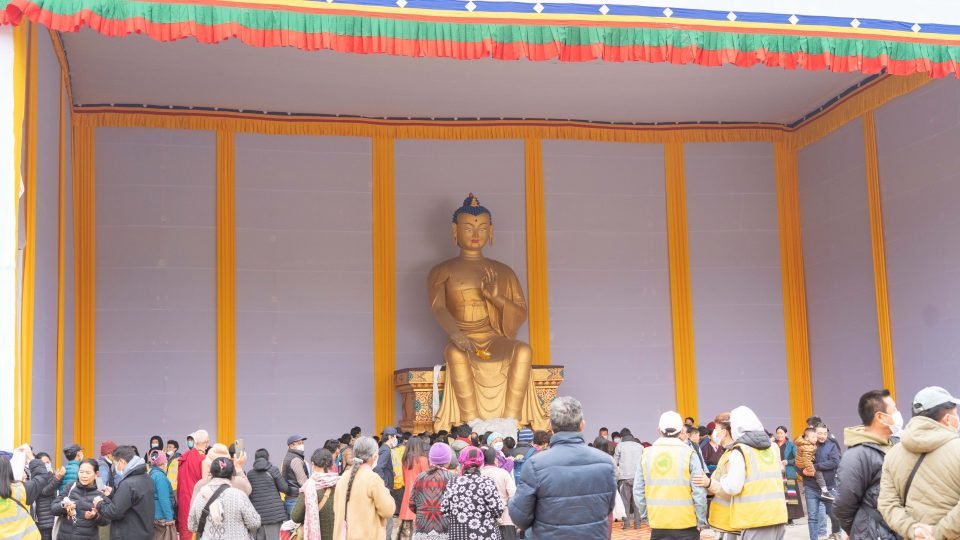
The existing 24-foot statue of Maitreya which will remain at The Dalai Lama Centre for Tibetan and Indian Ancient Wisdom in Bodhgaya, India, January 3, 2023. Photo by Ven. Lobsang Sherab.
The existing 24-foot Maitreya statue that is currently on the property has been refurbished and will remain there on the land. The large Maitreya statue in the enlightened aspect, which was a vision of Lama Yeshe, will be part of stage two of the development of the center.
Please join the entire FPMT community, students of His Holiness worldwide, as well individuals working to cultivate qualities of warm-heartedness and compassion into their lives for the benefit of all, in rejoicing in the continued development of The Dalai Lama Centre for Tibetan and Indian Ancient Wisdom.
You can follow important and inspiring news about His Holiness the Dalai Lama on the official website of His Holiness:
https://www.dalailama.com/news
We invite you to follow the teaching schedule of His Holiness on the Office of His Holiness the Dalai Lama’s official website.
- Tagged: dalai lama, his holiness the dalai lama
19
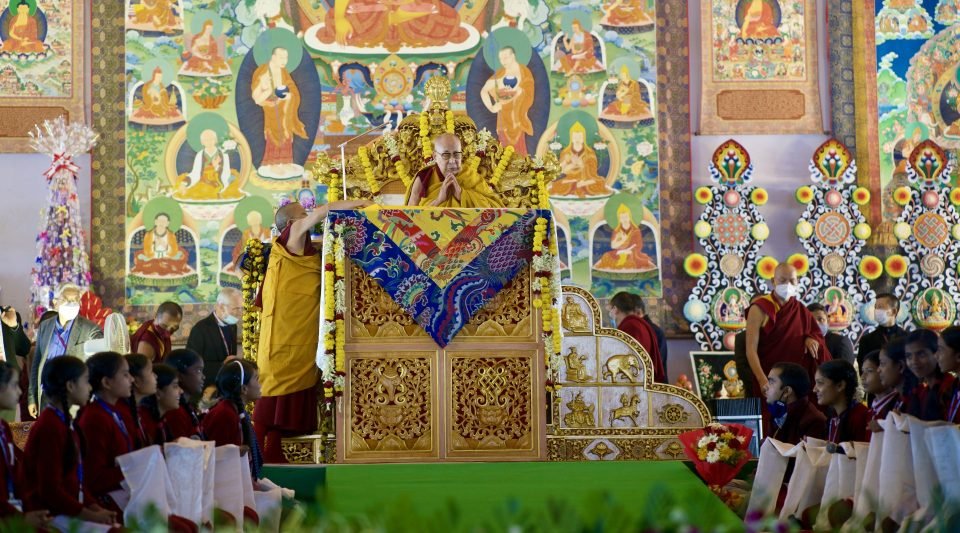
On the main stage of Kalachakra Ground, Bodhgaya, offering prayers before the teachings start. December 2022. Photo by Bill Kane.
By Frances Howland-Moscatt
More than 65,000 devotees attended the winter teachings of His Holiness the Dalai Lama in Bodhgaya, Bihar, India, December 29 – January 1. It was his first visit to Bodhgaya in three years, the last time being in January 2020, just before the pandemic changed the world. As well as the many Tibetans, there were people in attendance from the Himalayan regions including Nepal, Ladakh, and Bhutan; some wearing beautiful embroidered local costumes. Among the 3,700 foreign attendees were people from Mongolia, the Russian Buddhist Republic of Kalmykia, and Korea. This time there were no visitors from Tibet or China, due to the many pandemic-related border closures and lockdowns.
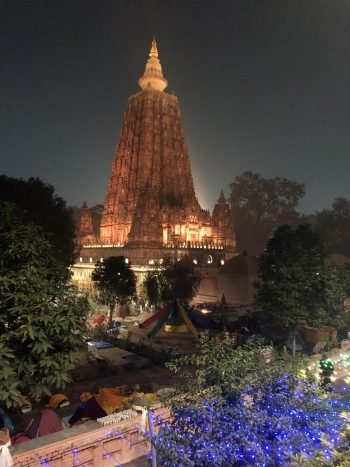
Stupa and grounds of Root Institute, Bodhgaya, December 2022. Photo by Jane Seidlitz.
Bodhgaya was bursting with energy. The restaurants and hotels that survived the pandemic closures were full again, street sellers and beggars were everywhere to be seen, and there was a carnival atmosphere in the dusty air.
FPMT students from around the world traveled to Bodhgaya to attend the teachings. For many it was the first time back since the last teachings His Holiness offered in January 2020. Many traveled directly from Kopan Monastery in Nepal after attending what was the first one-month November Course since 2019.
Root Institute for Wisdom Culture was once again buzzing with activity after a long period of closure. It was completely full with over 150 foreign guests including more than 30 FPMT sangha. Lama Zopa Rinpoche was in his house at Root, with the many colored light offerings illuminating the building. Other lamas there included Tenzin Phuntsok Rinpoche (the reincarnation of Geshe Lama Konchog), now 20 years old and studying at Sera monastery, nine year old Tenzin Rigsel Rinpoche (the reincarnation of Kopan’s late Khen Rinpoche Lama Lhundrup), the newly recognized young incarnation of Lama Zopa Rinpoche’s teacher, Dhakpa Tritul Rinpoche, and Sengye Rinpoche.
His Holiness taught for three mornings from December 29 on Nagarjuna’s Commentary on the Awakening Mind. Translated simultaneously into many languages and broadcasted on FM channels, it was also live-streamed for those unable to attend in person. Audience members could also watch the proceedings on a number of large screens, while monks ran among the crowds with salty butter tea and fresh warm Tibetan bread.
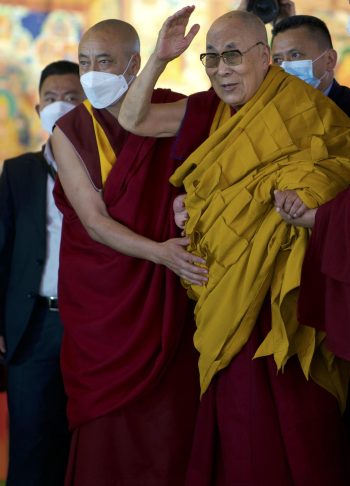
His Holiness the Dalai Lama waving to the crowd of attendees during the teachings at Kalachakra Ground, Bodhgaya, India. December 2022. Photo by Bill Kane.
His Holiness was driven each day in a large golf cart to the Kalachakra Teaching Ground, always smiling and waving to well wishers who gathered on either side of the road. At the conclusion of each day of teachings His Holiness came to the front of the stage while waving to the audience, in all directions, as the audience responded with applause and appreciation.
On the right of the stage sat the past and present leaders of the Sakya tradition, including the forty-first Sakya Trizin, who retired in 2017 when his eldest son Ratna Vajra Sakya was enthroned as the forty-second Sakya Trizin. On the left side were the leaders of the Gelug tradition, the Gaden Tripa, Sharpa Choje, and Jangtse Choje, along with H.E. Ling Rinpoche and many other high lamas both young and old, including Lama Zopa Rinpoche.
On the first day of teachings, Theravada monks, mostly from the two Thai monasteries in Bodhgaya, opened the proceedings with chanting of the Karuniya Metta Sutta in Pali, the Buddha’s words on loving-kindness. His Holiness started by saying, “This, the Seat of Enlightenment, it is the most sacred of the sites associated with the Buddha. Elsewhere he taught the Four Noble Truths and the Thirty Seven Harmonies of Enlightenment, but here we are reminded of the essence of all his teachings, which is to discipline the mind for the benefit of sentient beings extensive as space.”
Before conferring the Bodhisattva Vows, His Holiness shared his recent experience at the Wat-pa Thai Temple, “I saw a painting of the Buddha in front of me on the wall, and when I reflected on the Buddha I had a feeling that the Buddha came down and actually stroked my head, and there were some sweets and I had a very clear vision that the Buddha gave me a chocolate from amongst the sweets.” His Holiness added that if we carry out the practices of what the Buddha taught, it’s reasonable to feel he will be pleased.
On the third day His Holiness conferred the Arya Tara empowerment (jenang) saying, “Here, on behalf of this great gathering of people I’ve been requested to give a permission related to Arya Tara.” His Holiness then gave the jenang of the Twenty-one Taras. “While I go through the preparatory rites, please pray to Arya Tara that the Dharma may flourish, that people may be well and that teachers and those gathered here may live long. Keep in mind that the longer you live, the greater will be your opportunity to accumulate merit. What’s more, since Avalokiteshvara (Chenrezig) sits on the crown of my head, you all share a special bond with him, which means you will be cared for by him in life after life.”
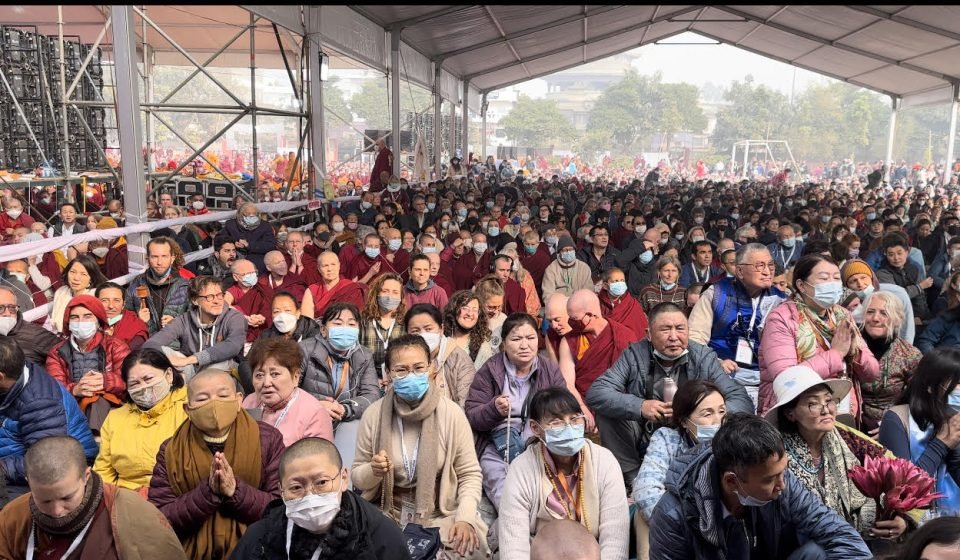
Audience of His Holiness the Dalai Lama’s teachings in Bodhgaya, December 2022. Photo by Bill Kane.
On the New Year morning of 2023 a long life puja was offered by the Gelug International Foundation, which represents the entire Gelug tradition. His Holiness pointed out the auspiciousness of the day by saying, “This was something that was not pre-planned as such, it just happened coincidentally, so this is the New Year of the Western calendar, which is over two thousand years old. So, this place, where you are offering this long life puja for me, is the very special place of Vajrasana, the Diamond throne.” His Holiness continued, “As for myself, in this very body for a hundred years I will serve the Buddha Dharma, particularly the Tibetan Buddhist tradition. I pray to be able to live long to serve the Dharma and I pray that as long as space endures, as long as sentient beings remain, I will abide to dispel the miseries of the world, this is my sincere prayer every day.”
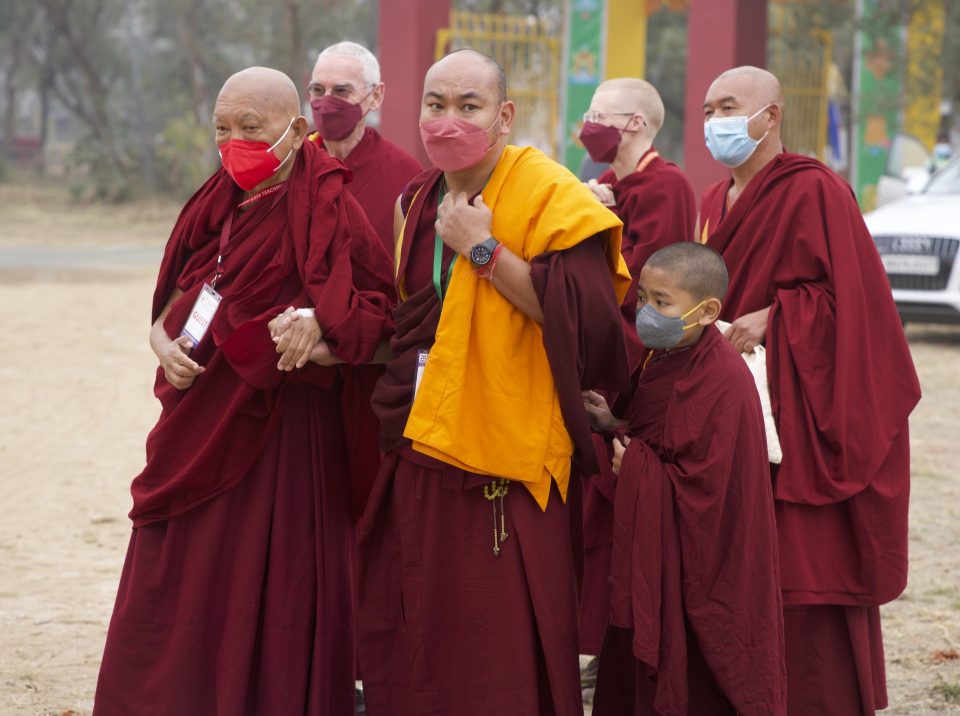
Lama Zopa Rinpoche, Ven. Roger Kunsang, Ven. Thubten Tendar, Ven. Holly Ansett, Thubten Rigsel Rinpoche, and Ven. Thubten Kunkhen on their way to His Holiness the Dalai Lama’s teachings, Bodhgaya, December 2022. Photo by Bill Kane.
While the Gaden Tripa Tenzin Lobsang Rinpoche read long life praises and dedications, a young violinist from Mongolia performed a beautiful song, a large group of women performed traditional dances and sang—a moving offering for His Holiness.
Ven. Khunphen from Germany has been the spiritual program coordinator at Tushita Meditation Centre in Dharamsala for 19 years, and is currently the acting director. She said, “[The teachings] are always inspiring, wonderfully organized, with hardly any queues. It was so good to see after the pandemic. Root Institute is our home; it is very comfortable, wonderful food, the cooks get up and have breakfast made for us by 4am, amazing, amazing.”
Ven. Lindy Mailhot from Tasmania, Australia has been the director of Chag-Tong Chen-Tong Centre for 20 years. “It has been extraordinary being here, an amazing sense of collective connections. Root Institute is wonderful with delicious food, great service, surrounded by so many holy beings, friends—it’s a big home for many of us.”
Ven. Thubten Kalden (Marcos Troia) from Brazil, is assistant director of Nalanda Monastery in France where 22 monks live and study. Ordained three years ago, he said, “For me this was very special now that I am a monk. I brought my mother here from Brazil. It has been wonderful to share with her all these moments—we did some pilgrimage, and attended the teachings. It is incredible to see how Root Institute has the capacity of doing so many things in such a busy period. In 2019, before COVID they had so many more volunteers helping.”
Bill Kane, an American photographer living in Thailand, commented, “Most people are appreciating being here since we have missed it for three years. You could see that people were very happy everywhere you went, even the security, everyone I encountered with my press pass, everybody was very happy to be back and have His Holiness back in Bodhgaya. I love staying here at Root Institute, especially to be away from the dust and pollution. Bodhgaya is always an extreme place to visit.”
Paloma Fernandez previously served as the FPMT Spanish National Coordinator, and is currently project manager for the planned Lama Tsongkhapa Retreat Center in Spain. She first came to India in 2006 and worked as a volunteer nurse at Root Institute’s Shakyamuni Buddha Clinic. This time, she said, “I came with a group of seven from Bilbao, it is amazing to be here, it’s like coming back home. The pandemic was such a difficult time for many of us running the centers, as soon as we saw in the news that His Holiness was teaching in Bodhgaya we all bought tickets. We thought, ‘We have to do it!’ My husband Koke (Alvaro) Muro is director of the Nagarjuna Wisdom Center in Bilbao and was accompanied by his mother. It is amazing to see all the lamas, to see Lama Zopa Rinpoche again; because with the pandemic, we did not know if that would ever happen again. It feels like reconnecting with what is the most important thing in our lives. The first few hours I was here at Root Institute, seeing the Indian staff I know from before, so happy to see them, I got hugs from some of them, really amazing, I am very happy.”
Luke Davis works as a teacher in Kathmandu. He said, “It is incredible to be in this magical land, to be in the presence of His Holiness, the embodiment of Avalokiteshvara, and receive succinct yet incredibly profound teachings that cut right to the heart on emptiness and bodhicitta. Root Institute is a sanctuary, especially the Stupa Garden where I am staying, with the Kadampa stupa and the many goats whose lives have been saved by Lama Zopa. Away from the hustle and bustle of Bodhgaya, it provides a wonderful opportunity to reflect on the day’s teachings and connect with Dharma friends.”
All in all, it was a wonderful four days, back with His Holiness the Dalai Lama in Bodhgaya, the unique, special and holy place where the Buddha sat under the Bodhi Tree and manifested enlightenment.
Frances Howland-Moscatt is the FPMT South Asia Regional Coordinator and lives in Kathmandu, Nepal.
You can follow important and inspiring news about His Holiness the Dalai Lama on the official website of His Holiness:
https://www.dalailama.com/news
We invite you to follow the teaching schedule of His Holiness on the Office of His Holiness the Dalai Lama’s official website.
11
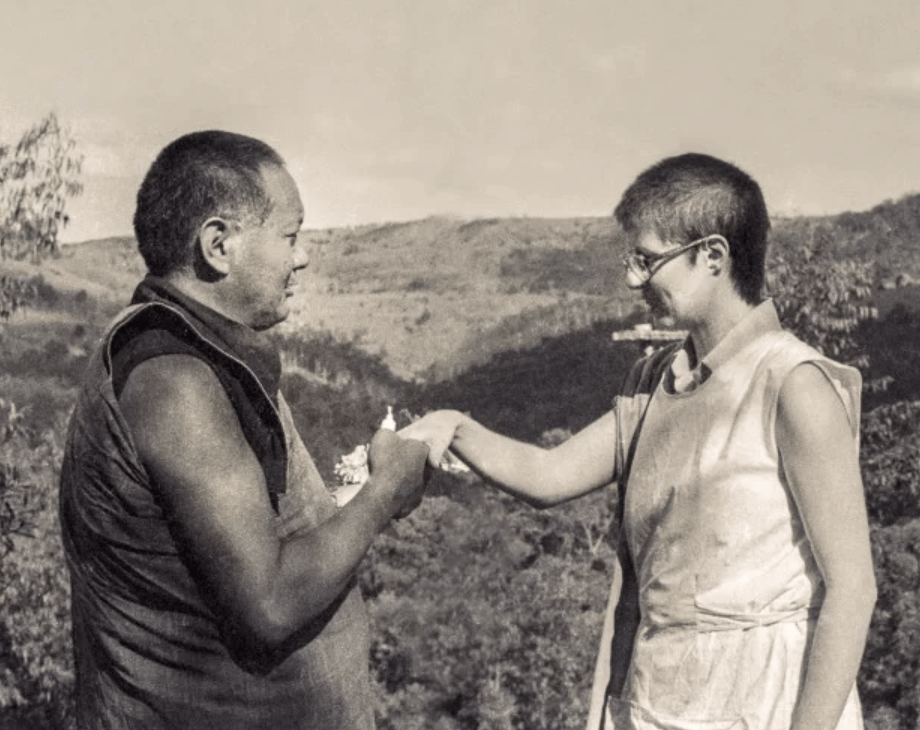
Ven. Margaret McAndrew with Lama Yeshe, 1981. Photo courtesy of Lama Yeshe Wisdom Archive.

We invite you to read Ven. Margaret’s story which, while taking place in 1974, has full relevance today for students of FPMT and anyone who has ever visited, or aspired to visit, Kopan Monastery.
Please read, “I Realized that My Life Couldn’t Be the Same Again” from the Mandala archives:
https://fpmt.org/mandala/archives/mandala-for-2013/october/ani-margaret-mcandrew/
FPMT.org brings you news of Lama Zopa Rinpoche and of activities, teachings, and events from over 150 FPMT centers, projects, and services around the globe. If you like what you read, consider becoming a Friends of FPMT member, which supports our work.
- Tagged: road to kopan, ven. margaret mcandrew
28
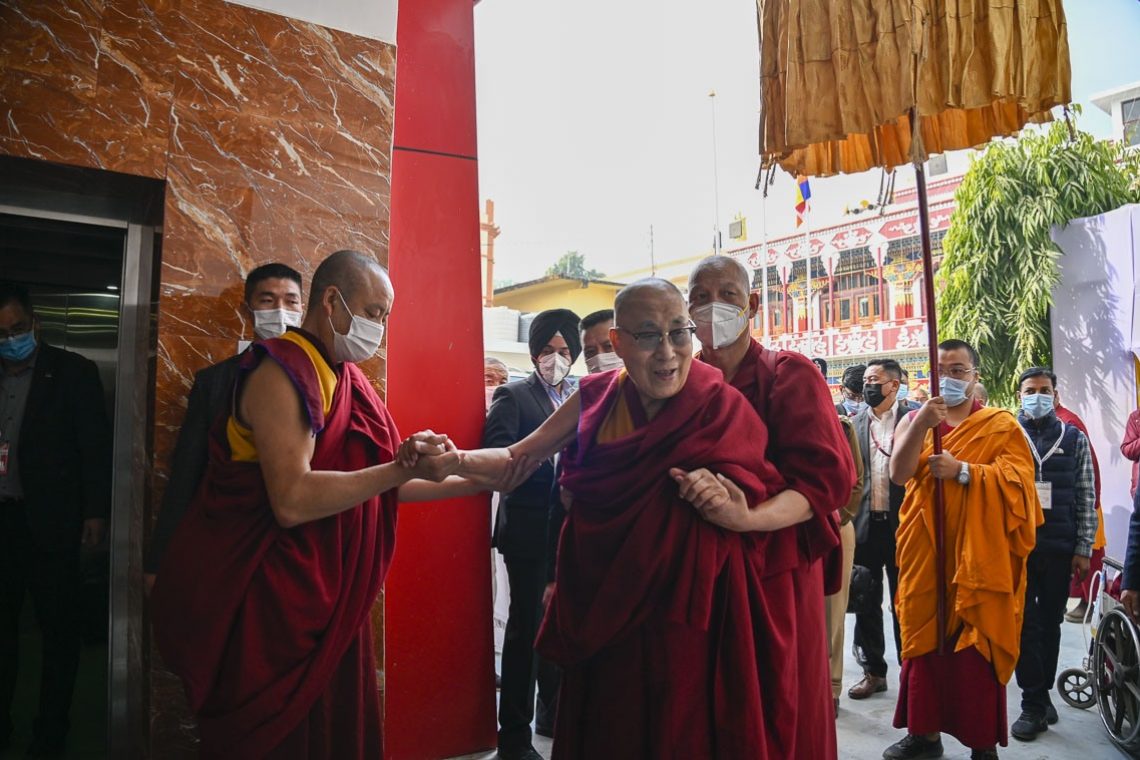
His Holiness the Dalai Lama arriving in Bodhgaya and visiting the Tibetan Monastery, December 22, 2022. Photo courtesy of the Office of His Holiness the Dalai Lama website.
His Holiness the Dalai Lama will be offering teachings at the Kalachakra Teaching Ground in Bodhgaya, India, starting December 29 through 31, with a long life puja offered on January 1, 2023. The events will be broadcast live on the website of the Office of His Holiness, as well as on the Dalai Lama Archive Youtube channel. The teachings are translated live in Tibetan, Chinese, English, Vietnamese, Japanese, Hindi, Korean, Spanish, French, German, Russian, Nepali, Ladakhi, Italian, Portuguese and Mongolian. Links to the webcasts in various languages can be found on the live webcast page for the teachings.
His Holiness will begin with offering a two-day commentary on Nagarjuna’s Commentary on Bodhicitta. On December 31, His Holiness will confer a jenang blessing (permission to practice) of the Twenty-one Taras. A long life puja will then be offered for His Holiness by the Gelug tradition on January 1 at the Kalachakra Teaching Ground, in the place of the Buddha’s enlightenment.
Here is the events schedule announced by the Office of His Holiness; all times shown are Indian Standard Time (IST):
December 29, 8am – 9:30am IST – Teachings on Nagarjuna’s Commentary on Bodhicitta
December 30, 8am – 9:30am IST – Teachings on Nagarjuna’s Commentary on Bodhicitta
December 31, 8am – 9:30am IST – 21 Taras Jenang Blessing
January 1, 8am – 9:30am IST – Long Life Puja Ceremony
We rejoice and hope you will be able to tune in to these wonderful events!
You can follow important and inspiring news about His Holiness the Dalai Lama on the official website of His Holiness:
https://www.dalailama.com/news
We invite you to follow the teaching schedule of His Holiness on the Office of His Holiness the Dalai Lama’s official website.
- Tagged: dalai lama, his holiness the dalai lama
21
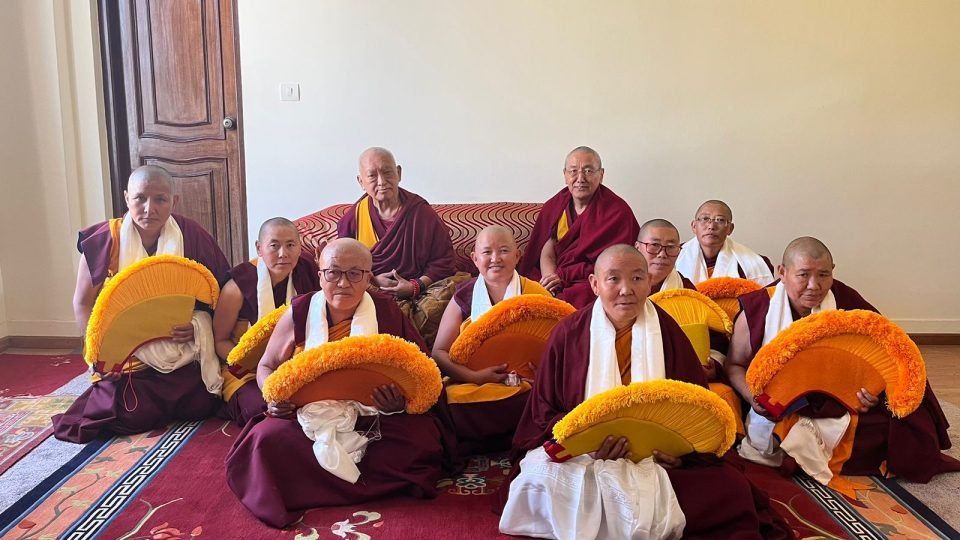
Khen Rinpoche Geshe Chonyi, Lama Zopa Rinpoche, and eight geshemas of Khachoe Ghakyil Nunnery, Nepal following the ceremony on December 15, 2022. Photo by Ven. Lhundrup Topgye.
Khachoe Ghakyil Nunnery has announced that four of their senior nuns, Ven. Lobsang Dolma, Ven. Thupten Choedon, Ven. Thupten Sangmo, and Ven. Lobsang Dolkar, graduated as geshemas on November 18, 2022. They were joined by six other nuns from nunneries in India, four coming from Jangchub Choeling Nunnery in Mundgod, and two from Geden Choeling Nunnery in Dharamsala.
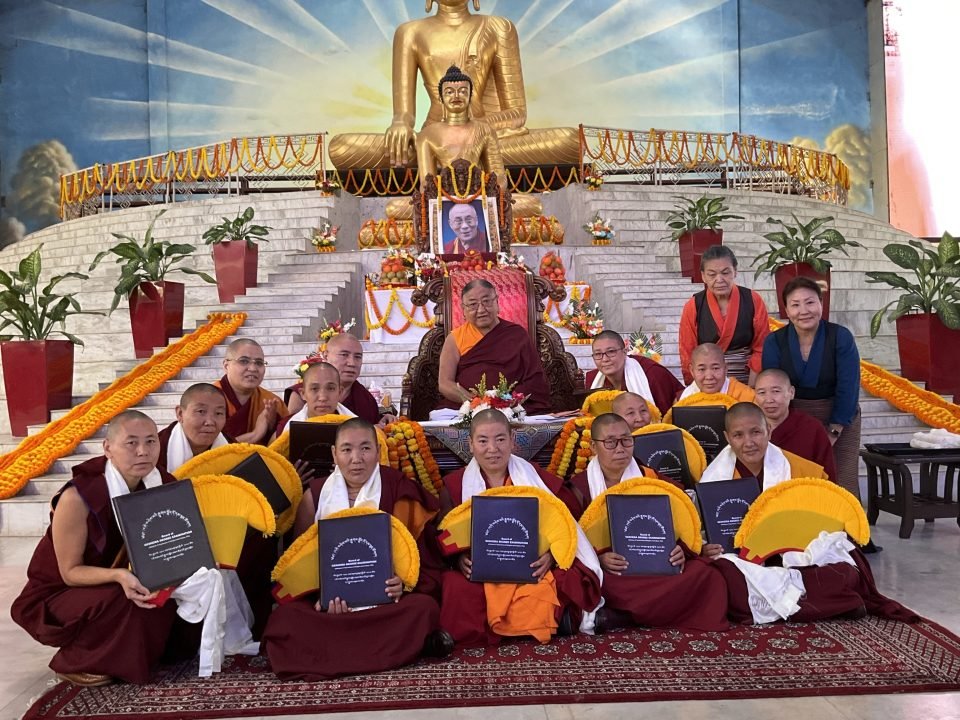
All ten new Geshe-mas with His Holiness the forty-first Sakya Trizin, Bodhgaya, India, November 18, 2022. Photo courtesy of Kopan Nunnery.
The four new geshemas are the latest group of graduates from Khachoe Ghakyil Nunnery to complete their Geshema degree. They and the six other new geshemas received their degrees from His Holiness the forty-first Sakya Trizin in Bodhgaya, India.
The sangha of Kopan Nunnery shared their congratulations to their new geshemas:
“We, the congregation of Khachoe Gakhil Ling Nunnery (Kopan Nunnery), would like to convey our hearty congratulations to every geshema of 2022 from three nunneries. We sincerely rejoice for your success and may the Buddha Dharma continue to prevail & prosper for the sake of all sentient beings. May all the great spiritual masters live long to selflessly continue their guidance that the world needs most.”
According to the Tibetan Nuns Project, there have been 54 nuns to complete their examinations since women formally gained access to the full Geshema degree path in 2012. The first group of nuns to graduate was in December 2016, with His Holiness the Dalai Lama presiding over their examination ceremony.

The nuns during their final examination ceremony, Bodhgaya, India, November 18, 2022. Photo courtesy of Kopan Nunnery.
The Geshema degree is the same course of study as the Geshe degree, with the feminine “ma” added just to delineate gender. The path to becoming a geshema begins after completing 17 years of monastic study. Those that qualify and desire to move onto the geshema degree path must then complete four years of rigorous oral and written examinations, including a successful thesis defense.
Prior to the historic change in 2012, nuns did not have access to the four-year Geshe degree path as monks did. The first to achieve the title of Geshema was the German nun Geshema Kelsang Wangmo, who completed her degree at the Institute of Buddhist Dialectics (IBD) in McLeod Ganj, India, a year prior in 2011. A nuns committee meeting was held in 2012, followed with the announcement by the Tibetan Administration’s Department of Religion and Culture that the full degree was now available to nuns.

Ceremony for the eight new geshemas at Khachoe Ghakyil Nunnery Nepal, December 15, 2022. Photo by Ven. Lobsang Sherab.
On December 15 a ceremony was offered at Khachoe Ghakyil Nunnery to the four new geshemas as well as the four who completed their degrees in 2019. This ceremony started with Sixteen Arhat Puja with Lama Zopa Rinpoche and Khen Rinpoche Geshe Chonyi in attendance. Ven. Roger Kunsang made an offering on behalf of the entire FPMT organization and invited them to teach in the future.
Please join us in rejoicing in the accomplishments of these new graduates and all of the geshemas helping pave new roads of opportunity, equity, and leadership for women in Tibetan Buddhism, and their efforts in teaching and preserving the Mahayana tradition.
Geshema Namdol Phunsok Teaching at Detong Ling Nunnery, Spain
In 2016, Geshema Namdrol Phunsok was one of two nuns from Khachoe Ghakyil Ling to receive their Geshema degree at Geden Choeling Nunnery in Dharamsala, India. We are delighted to share that she will be teaching at Detong Ling Nunnery, Spain, from February 21- March 23, 2023. These teachings will have in person and Zoom options with Spanish and English translations. These teachings are appropriate for students who already have already a basic understanding of Buddhist concepts
Sponsorship is also available for all aspects of this event.
For questions and further information about the teachings with Geshema Namdrol Phuntsok or sponsorship of the event, please contact Detong Ling Nunnery.
The FPMT Supporting Ordained Sangha Fund offers opportunity to support nuns and monks in providing for their education, healthcare, food, housing and other essential needs.
- Tagged: geshemas, nuns, tibetan nuns project
19
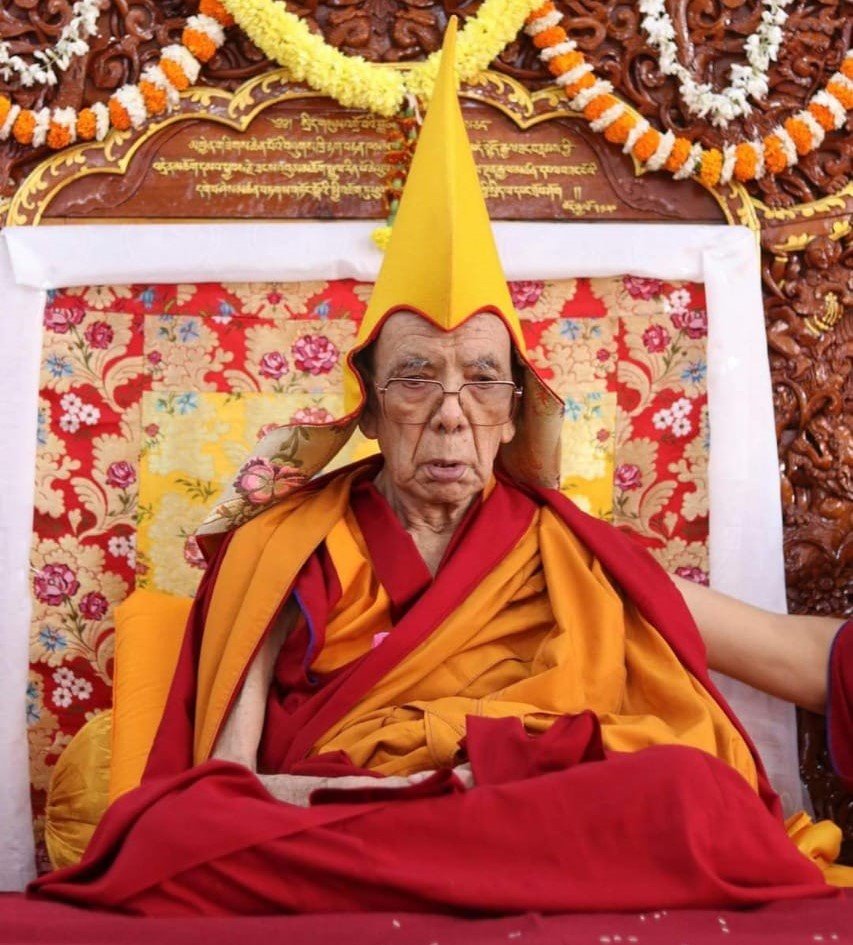
The 102nd Ganden Tripa Rizong Rinpoche. Photo courtesy of Drepung Loseling Monastery Facebook page.
The 102nd Ganden Tripa Rizong Rinpoche, one of Lama Zopa Rinpoche’s gurus, passed away on December 8, 2022 at Drepung Monastery, Karnataka, India, at age 94.
Ganden Trisur Rizong Sras Rinpoche was born in Ladakh, India in 1928, to an aristocratic family, his father being a prince of Ladakh. At age four, he was recognized as the previous Sras Rinpoche by the thirteenth Dalai Lama, who had founded the well-known Rizong retreat hermitage. After being recognized, Rinpoche entered monastic life. In 1948, Rinpoche moved to Tibet to continue his studies at Drepung Loseling Monastery in Lhasa. He remained there in Tibet until the Chinese invasion in 1959, when he fled back to India.
Back in India, Rizong Rinpoche would later be named the abbot of the Drepung Loseling Monastery in India by His Holiness the Dalai Lama, in 1984. Rinpoche later became abbot of Gyume Tantric Monastery, and then served as Ganden Choje, the position held before becoming Ganden Tripa (Ganden Throneholder). In 2009, Rinpoche was appointed as the 102nd Ganden Tripa, the spiritual head of the Gelug lineage, and served the traditional full-term of seven years, retiring from the position in 2016.
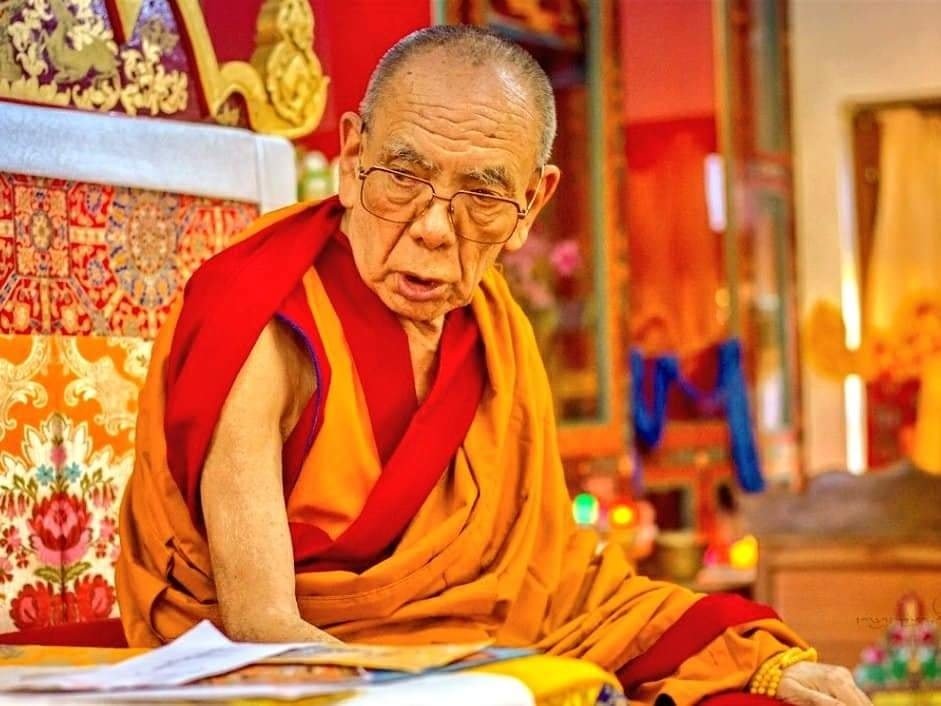
The 102nd Ganden Tripa Rizong Rinpoche. Photo courtesy of Voice of Tibet Facebook page.
The Central Tibetan Administration offers some of Rinpoche’s biography:
“Rinpoche …made the practice of meditation his principal focus in life, and has conducted numerous extensive retreats, including a three-year tantric retreat on the Yamantaka mandala in a remote hermitage in Ladakh. Through his achievements in practice and scholarship, he represents the pinnacle of the Sutra and Tantra traditions.
Rinpoche was renowned for his Tantric powers, and [was] frequently called upon by His Holiness the Dalai Lama to lead ceremonies for healing and other similar purposes.”
His Holiness the Dalai Lama shared some words on December 9, 2022, the morning after Rizong Rinpoche’s passing, while at a conference on secular education:
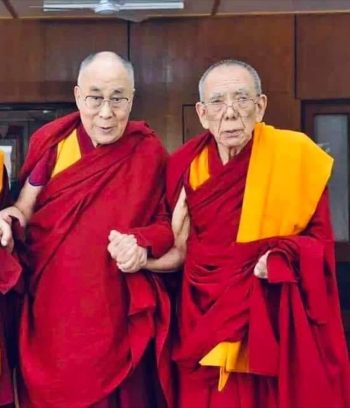
His Holiness the Dalai Lama with Ganden Trisur Rizong Rinpoche. Photo courtesy of Drepung Loseling Monastery Facebook page.
“Today, many old friends have gathered here. It’s with sadness that I’ve heard this morning that Kyabje Rizong Rinpoche, the former Ganden Throneholder, passed away last night. Although his passing away is a natural part of life, I’m sad because he was one of my teachers.
“I once visited him in Ladakh at a time when he was completing a long meditation retreat. He received me sitting on the very seat where he had been meditating so long and gave me the transmission of Nagarjuna’s Six Collections of Reasoning. His death reminds me of the Four Seals:
All conditioned phenomena are transient.
All polluted phenomena are unsatisfactory or in the nature of suffering.
All phenomena are empty and selfless.
Nirvana is true peace.
“Unless we cut the chains of ignorance, we will be unable to stop the cycle of suffering. We have to understand that no matter how they appear, things have no independent or absolute existence.”
Lama Zopa Rinpoche, Khen Rinpoche Geshe Chonyi, and the Kopan Lama Gyupa monks offered Yamantaka self initiation upon the news of this great lamas passing.
We are profoundly sad at the incredible loss of this remarkable meditation master, scholar, and teacher, who was one of Lama Zopa Rinpoche’s gurus. We hope this outline of his life will be cause of rejoicing in his many good deeds and deep impact.
While reading obituaries we can also reflect on our own death and impermanence prompting us to live our lives in the most meaningful way. More advice from Lama Zopa Ripoche on death and dying is available, see Death and Dying: Practices and Resources (fpmt.org/death/).
To read more obituaries from the international FPMT mandala, and to find information on submission guidelines, please visit our new Obituaries page (fpmt.org/media/obituaries/).
16
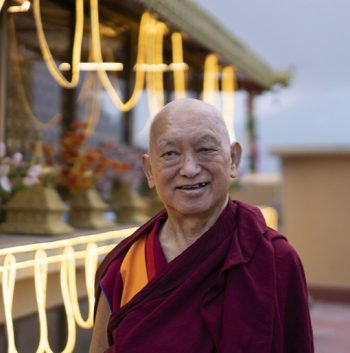
Lama Zopa Rinpoche at Kopan Monastery, May 2022. Photo by Ven. Lobsang Sherab.
FPMT International Office wishes you a most joyous holiday season and new year. We are very pleased to share with you our December 2022 e-news which is packed with news and teachings from Lama Zopa Rinpoche, causes for rejoicing, resources for your Dharma practices, and opportunities within the organization.
Please explore this issue in full including:
- News of an upcoming long life puja for Lama Zopa Rinpoche
- Information about Rinpoche’s teachings at Kopan Monastery
- Completion of a 42-foot stupa in South India
- Details of grants offered to ordained Sangha in 2022
- Materials for your study and practice
and much more!
Please read this month’s e-news in its entirety.
Have the e-News translated into your native language by using our convenient translation facility located on the right-hand side of the page.
Visit our subscribe page to receive the FPMT International Office News directly in your email inbox.
- Tagged: enews
8

Lama Zopa Rinpoche with brother Sangye Sherpa (left), and sister Ani Ngawang Samten (right), Lawudo, Nepal, June 2008. Photo by Ven. Thubten Kunsang.
This letter below by Frances Howland was originally published in the Love Lawudo Newsletter #14, November 2022. It celebrates the service of Sangye Sherpa, the brother of Lama Zopa Rinpoche, and the development of the Lawudo Gompa and Retreat Center during his time as director. Lawudo is a small and remote village in Nepal, and was the home of the Lawudo Lama, a hermetic yogi who spent most of his life in retreat in a cave above the village. Lama Zopa Rinpoche was recognized as the reincarnation of the Lawudo Lama, so the village holds a special connection with the FPMT organization.
By Frances Howland
Sangye is the younger brother of Kyabje Lama Zopa Rinpoche and his sister Ven. Ngawang Samten. He was born in 1948 in the village of Thame in Solu Khumbu, one month after their father died. They were a poor Sherpa family, and the early years were filled with many hardships due to their father’s untimely death.
In 2008 Lama Zopa Rinpoche requested Sangye to become the director of Lawudo Retreat Centre and for the next 13 years he worked hard raising money and maintaining and developing Lawudo Retreat Centre in accordance with the wishes of Lama Zopa Rinpoche.
The immediate advice from Rinpoche was to tear down the old monastery and build a new, larger gompa that could accommodate 500 monks. Built in 1968 it was in an extremely poor condition and at risk of collapse at any time. The building was sinking into the ground, the front pillars were crooked, and the walls were visibly leaning outwards. However, the senior Lama from Thame monastery, Lama Zopa’s uncle Ashang Yonden, and other Lamas recommended that the old gompa should be preserved as a pilgrimage site because Lama Zopa and Lama Yeshe themselves had supervised and planned the construction and carried some of the stones used in the building. Following this input, Sangye decided to reinforce the foundations with concrete while adding concrete beams and pillars in strategic places, while keeping the original building.
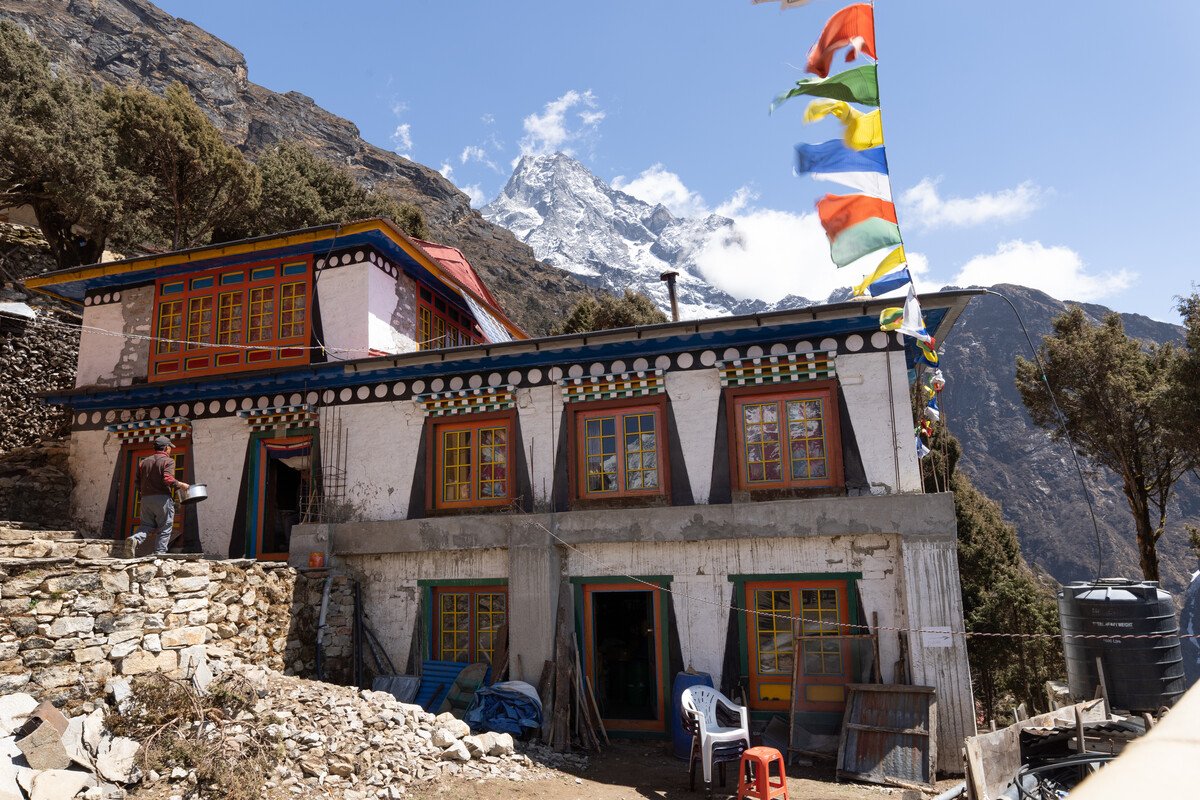
Lawudo Gompa, Nepal, April 2019. Photo by Harald Weichhart.
The difficulties of building in the Khumbu region cannot be stressed enough. In 1976 the Khumbu region became the Sagarmatha National Park and was declared a World Heritage Site. Everything must be carried or flown into the area. Even wood used for building cannot be cut from local trees. Sangye had to organize cargo helicopters to carry all the materials he used for all the projects he undertook. This also increased the cost substantially with each helicopter costing around 3,000 US dollars plus the porter charges to carry the goods from the Syangboche airstrip to Lawudo. Despite these challenges, new guest rooms, a new kitchen, major renovations and extensions to the existing buildings plus the construction of a library with a balcony overlooking the valley were all completed. The logistics of all of these projects are mind-boggling.
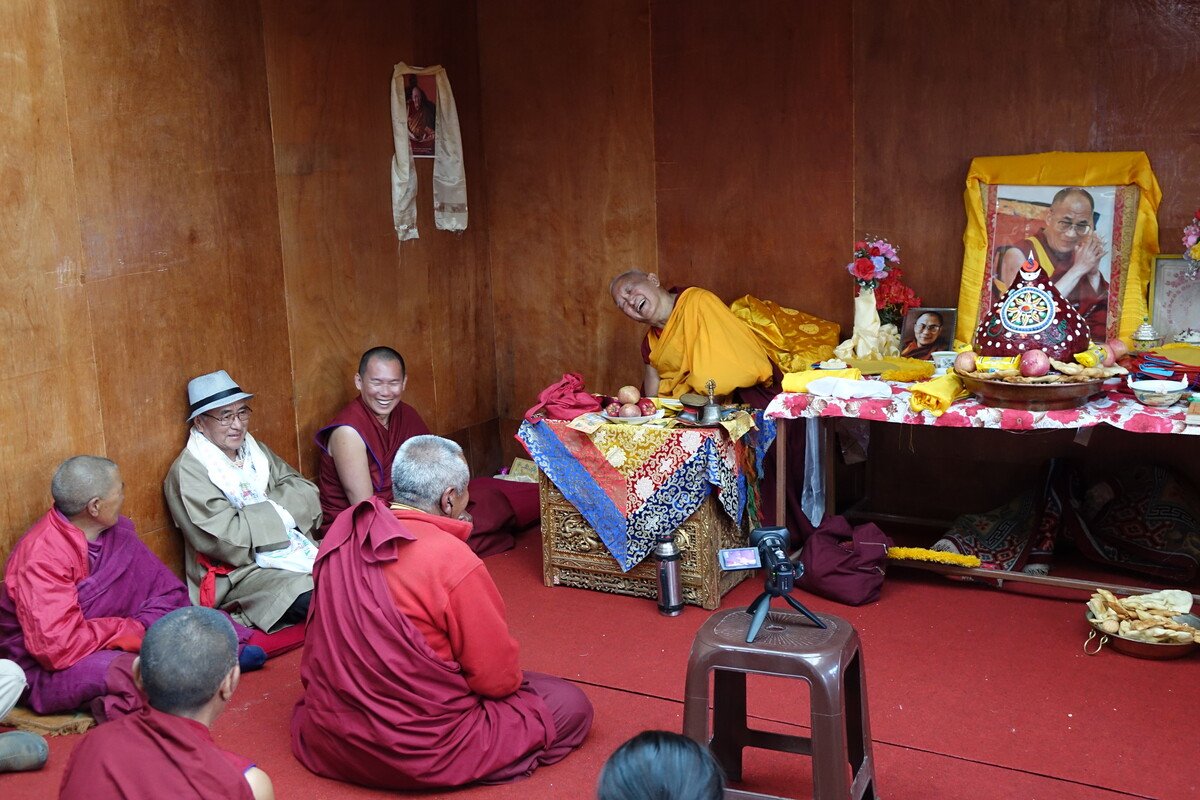
Lama Zopa Rinpoche at Lawudo Retreat Center, with sangha and his brother Sangye Sherpa (with hat), Lawudo, Nepal, April 2015. Photo by Ven. Roger Kunsang.
In late March 2015 a group of us accompanied Rinpoche to Lawudo. Sangye and Ven. Ngawang Samten hosted everyone and there was a big opening ceremony for the new library building, with a procession of monks from a nearby monastery. On April 25th, Lama Zopa Rinpoche had just left Lawudo to return to Kathmandu when a major earthquake measuring 7.6 shook Nepal. No one in Lawudo or the surrounding villages died but most buildings and many stupas on the trails were damaged. At Lawudo the impact was severe. There were cracks in the gompa, the dining room roof fell down, the toilets collapsed, the stone walls of every building cracked open, and the new library where we had just had the opening ceremony was cracked with many stones fallen. Sangye immediately organized an Earthquake Relief for Damage at Lawudo to help fund the repairs.
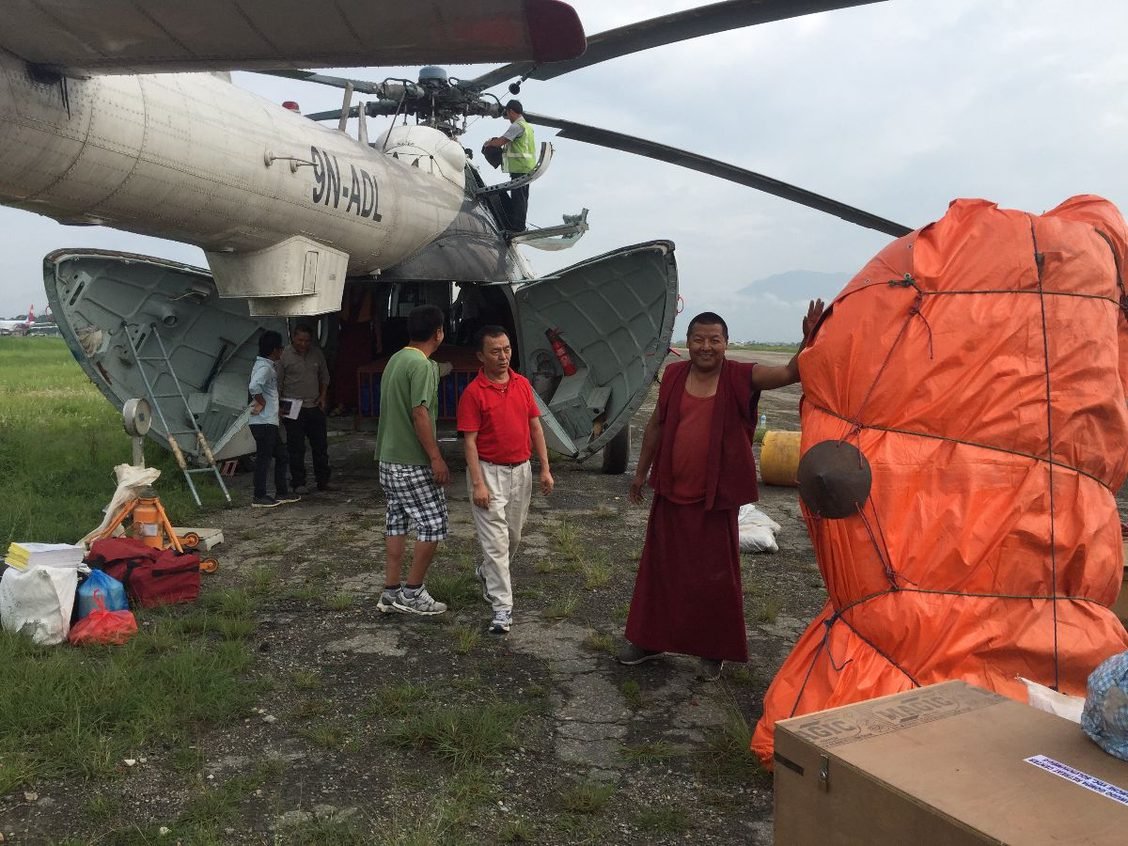
The 22-foot statue of Padmasambhava arriving to Lawudo by helicopter, with Ven. Tashi Nyima, pictured.
Another task that Lama Zopa gave his brother was to install a 22 feet-high Padmasambhava statue in the gompa at Lawudo. In the standing aspect of Sampa Lhundrup, it was to face eastwards and be surrounded by seven life sized manifestations, all cast in copper with gold finishing. Sangye commissioned the statues from the skilled Sakya artisans of Patan down in the Kathmandu valley. On 27 June 2016 the statues were helicoptered into Mende, the hamlet closest to Lawudo. 35 Sherpas were needed simply to carry the main statue up the steep mountainside to Lawudo.

The 22-foot statue of Padmasambhava residing in Lawudo Gompa.
In May 2021 a pilgrimage to Lawudo was organized for Lama Zopa and a group of students. Sangye and Ven. Nyima Tashi spent months in Lawudo making sure all the building work was completed and the statues were ready to be consecrated. By then the COVID pandemic was in its second year, and by May the Delta variant was claiming lives in Nepal and India. Once again Nepal went into a total lockdown and the visit to Lawudo was cancelled. Nevertheless Sangye and his team continued undaunted with their extensive program of repairs and upgrades. These included introducing a damp course for the Lawudo cave, building a support wall behind the monastery building, and installing safer steps and walkways for the increasingly elderly Lawudo family.
Another extraordinary achievement from Sangye’s time as Lawudo director was to bring fresh running water to Lawudo and 38 other households in the valley. Anyone who has been to Lawudo will know what an extraordinary feat of engineering would be necessary for such a project. The water is piped at 1.7 litres per second from a height of 4500m through a pipe clamped to the vertical rock faces above. The pipeline was inaugurated in November 2019 and is making an incalculable contribution to the health and well-being of the local population and its livestock. The budget was millions of rupees, much of which was fundraised by Sangye.
Before dedicating his time to Lawudo, Sangye was a successful businessman, and was also involved in the trekking and tourism business. He lives in Chabhil not far from the Boudha stupa with his wife Nyima, his airline pilot son Pemba, and his daughter-in-law Sarita Chhetri and two grandchildren. His other three children are married and live in the UK and US.
Please join us in rejoicing at the amazing contribution that Sangye has made to fulfilling Lama Zopa Rinpoche’s vision for Lawudo, and in making prayers for his health and long life.
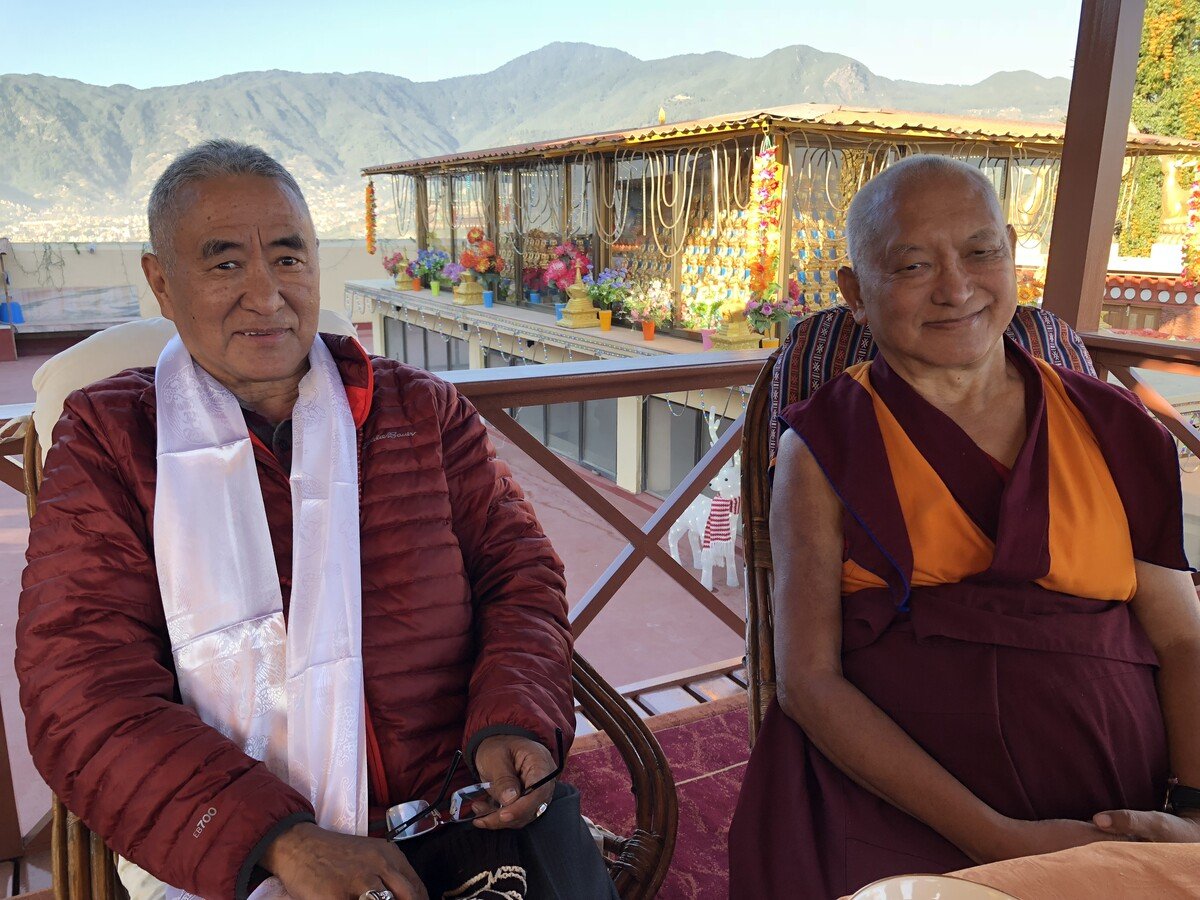
Lama Zopa Rinpoche with his brother, Sangye Sherpa, Kopan Monastery, Nepal, 2017. Photo by Ven. Roger Kunsang.
- Tagged: lawudo, lawudo retreat centre
5
Big Love Summit 2022
Following the tradition of FDCW’s Big Love Festival in 2020 and the Compassion and Wisdom in Action 2021, the Big Love Summit 2022 was successfully held from November 14-19 as a six-day online conference.
FDCW’s executive director, Victoria Coleman, shares the update.
FDCW hosted its third annual conference in November this year celebrating Big Love. After a successful series of six Compassion Webinars held throughout the year, we wanted to examine how can we open our hearts more fully; what biases and judgments separate us from others; how can we find pathways for more connection in our lives; and how can we deepen and strengthen our compassion while remaining joyful.
It all starts with our own mind. Paula Chichester opened the summit with guidance on experiencing “Love, Presence, and Embodiment” as a basis for developing our compassion. She said, “Cultivate an inner landscape of nourishment, love, and acceptance. Once we feel safe and connected, awareness naturally arises. Then genuine compassion can grow.”
In “Reclaiming Joy,” Tenzin Chogkyi challenged the idea that spirituality is all about striving and pushing, never resting. If we skip resting, we quickly become joyless, even resentful. She led a meditation to show us ways to reconnect with our joy. “Use joy as a litmus test for your work to benefit others,” she said. “If there’s no joy, it’s time to give yourself permission to rest.”
In “Embodying Loving Awareness in Difficult Times,” Claudia Van Zuiden offered a life-affirming presentation, full of hope, sharing techniques for connecting with our heart and our true nature of love. When we forgive (ourselves and others) the heart softens, it is no longer tight. She asked, “Can I let go of all the labels I have about myself and if I do, what is left?”
During “Breathing In Equanimity,” Dr. Joey Weber said our compassion goes up or down depending on how the object of our compassion is relating to us. Equanimity can help us by relating to others in a healthier way and bringing more emotional balance. Equanimity is not just an intellectual idea, but has to be practiced, familiarized, internalized, so you feel it and it heals you and others.
In “Heart Practices for Difficult Times,” Paul Wielgus offered a session rich in inspiration, practical advice, and joy. He began by quoting Thich Nhat Hanh on interbeing: “We are all connected by the sheer fact of our human existence”. He spoke of resonance—within our own heart, with one another, and with Mother Earth. He shared a joyful video of children transforming a concrete parking lot in Oregon into a forest with fruit-bearing trees inspired by the Global Tree Initiative.
In “Compassionate Activism,” Ven. Robina Courtin said wisdom begins in our own mind, which is also the source of all our unhappy emotions. By recognizing this, we can begin to feel compassion for ourselves. We can go beyond the narrow sense of self and realize we’re all in the same boat. This brings optimism and confidence that even the smallest action we can do to help others, counts. We develop the courage to never give up. All our actions, from lending a hand to our next-door neighbor to helping stop the destruction of our planet, need to be grounded in wisdom. As His Holiness the Dalai Lama says, “Compassion is not enough; we need wisdom.”
In “We Are All One Family,” Niv Agam, Ofir Levit, and Mairan Broadbar from Dreamers Home (a non-profit in Israel) shared how FDCW’s tools for wisdom and compassion are transforming the lives of people in Israel, especially those experiencing loneliness, living in poverty or struggling with sickness. We heard about the Jaffa Balcony, a place that brings together women from Christian, Judaic, and Islamic traditions to share their common values and yummy food. The non-religious framework provided by FDCW’s 16 Guidelines proved essential for these women to explore values openly and without fear. Ofir shared, “A pair of good eyes, a smile, and a willingness to know the other person can be a seed of a true friendship.”
In “Spreading Joy and Gratitude in Your Community,” Alison Murdoch offered a beautiful meditation on kindness. She described organizing a week-long Kindness Festival in her hometown. Local people found all sorts of creative ways of sharing kindness: painting inspiring quotes about kindness onto rocks and scattering them around town, knitting hearts and toys and leaving these to be “found” by children, kindness assemblies in local schools, and a public meeting debating kindness in politics. There was no budget or funding. And it all began with a few people sharing ideas over hot chocolate on a Sunday afternoon.
In “The Power of Resiliency,” Ceci Buzon identified the 16 Guidelines and its four wisdom themes as a key way to develop our resilience. We need to train ourselves to think in a more flexible, less rigid way. She explained the Giants and Dwarves game for children to learn flexible thinking. Can we see problems from several different perspectives? She emphasized the importance of focusing on what we can do to help rather than what we cannot do. This gives us courage and combats feelings of depression or overwhelm. Resilience brings us hope and lets our children feel hopeful too.
In “We Are All Connected,” Pam Cayton shared her Seven Steps program for awakening kindness in children. The first step involves a simple “centering” process where children go inside and ask deeply, “What do I want?” What emerges is that we all want to feel happy and to be treated with kindness. This is the beginning of empathy—an understanding that if I want to feel happy, so do others. Then the “how” to be happy is explored. This involves feeling grateful for what we have and seeing how everything we enjoy is dependent on others. Pam shared ways that we can help children understand that our perceptions of the world are relative. How no-one can “make me angry.” Nobody makes your emotions, you are in charge of them. She also spoke about the lost art of listening—how connection and communication feels good—deepening our empathy and developing our compassion.
To watch the presentations (in English, Portuguese, Spanish, Russian, Chinese, French and Italian), please visit The Big Love Summit 2022.
To learn more about Universal Education for Compassion and Wisdom:
fpmt.org/education/secular/universal-education-for-compassion-and-wisdom
1
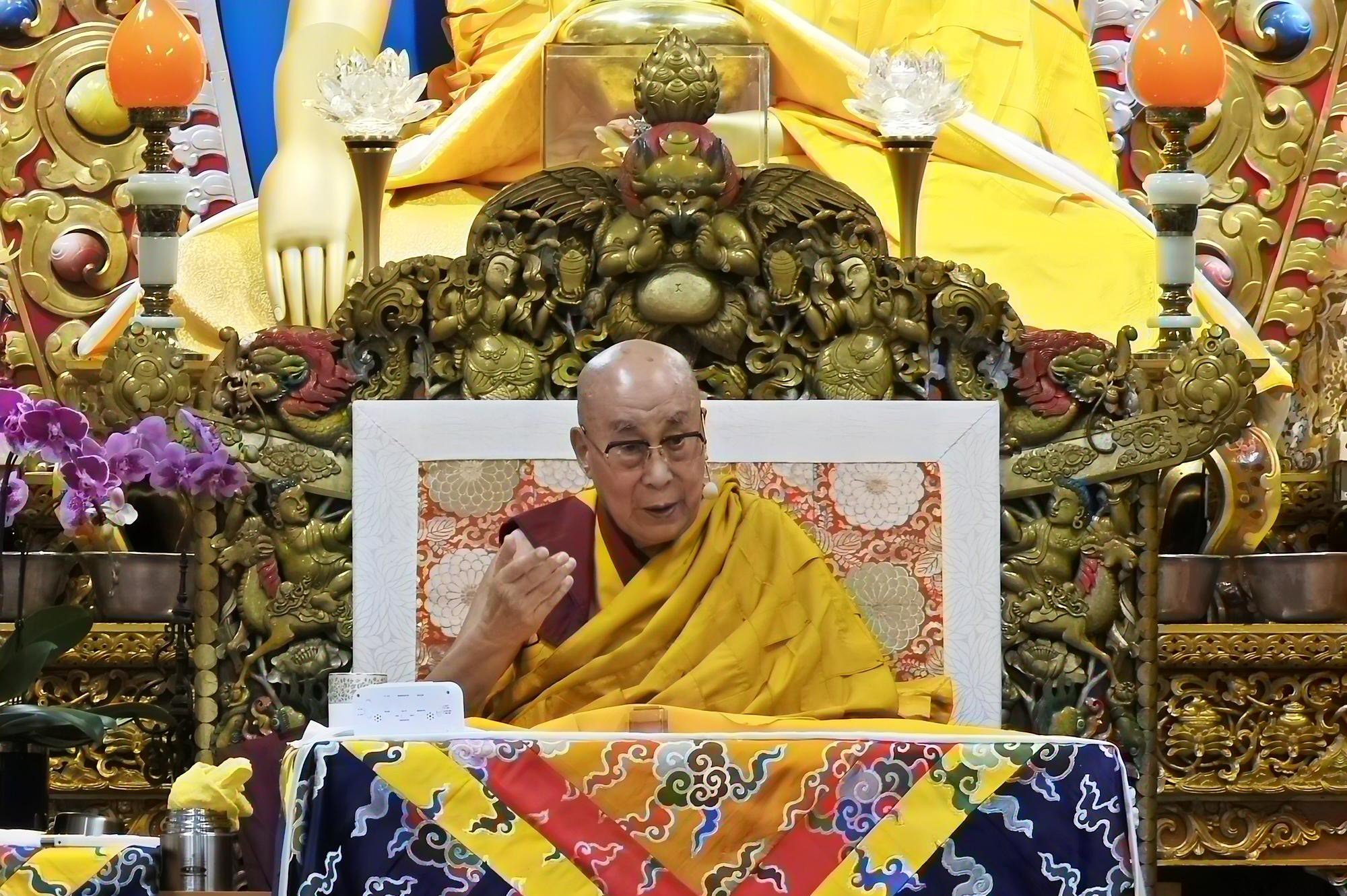
His Holiness the Dalai Lama giving public teachings in person, McCleod Ganj, H.P., India, September 2022. Photo by Jean-Luc Castagner.
Buddhist students around the world have learned to appreciate technology and the blessings of Zoom since the Covid-19 pandemic halted travel and large events or gatherings for most of us for nearly three years. In September, His Holiness the Dalai Lama offered an in-person teaching in McLeod Ganj, Dharamsala, at his monastery, Namgyal Monastery.
We are so happy to share two moving reports of these teachings – one from long-time French student Jean-Luc Castagner, who was able to speak to other students from around the world about their experience with His Holiness’s teachings, and one from Ven. Tenzin Tsultrim, on behalf of a group from Amitabha Buddhist Centre, Singapore, who attended these teachings together.
Return to McLeod: His Holiness the Dalai Lama’s Teachings in a Post-COVID World
By Jean-Luc Castagner
His Holiness the Fourteenth Dalai Lama has been giving public teachings for decades in the little town of McLeod Ganj above Dharamsala (Himachal Pradesh, India), and the flow of Injis (English speakers/Westerners, in Tibetan) that marks the streets here is a constant indicator of the importance and relevance that His Holiness’s message is always touching a wide audience.
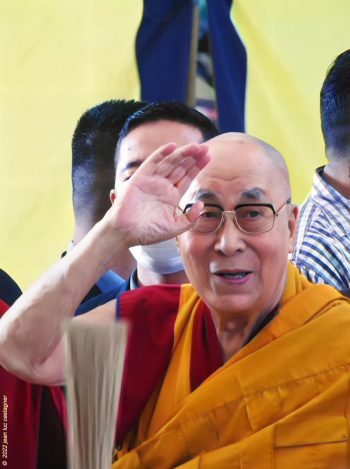
His Holiness the Dalai Lama, September 2022. Photo by Jean-Luc Castagner.
The pandemic that has put these public teachings on hold is now almost behind us and we are now able to attend in person and be in the presence of His Holiness again. In the mornings of September 15 and 16, 2022, His Holiness gave a two-day teaching on Chandrakirti’s Entering the Middle Way, a prominent text written as a commentary to Nagarjuna’s Mūlamadhyamakakārikā (The Fundamental Verses on the Middle Way). It clarifies Nagarjuna’s Middle Way approach with respect to the lack of intrinsic existence as propounded by the Madhyamika Prasangika school of thought. The auto-commentary was further written to clarify its meaning for Chandrakirti’s students. His Holiness has given similar teachings on these texts many times in the past.
Two and a half years have passed since my return to McLeod Ganj. March 21, 2020 was my last day there. That morning, all the students of the Lotsawa Rinchen Zangpo Translation Program (LRZTP), of which I was a part, formally graduated. I remember that time very clearly because of the commotion that the newly emerging virus, now famously known as Covid-19, was causing havoc all over the planet, and the prospect of being stuck in India for a long period of time, in probably dire circumstances, was daunting to me and many other people. My friend and classmate, Lola, and I decided to travel back to France together quickly, after experiencing a few plane cancellations and delays. It turns out that we were on one of the last planes that were allowed to leave India on the morning of March 22, as all of Indian air travel was to be shut down at 6 am on that day. A handful of my classmates had decided to stay in India, thinking that this situation would not last long, that it too would come to pass. Little did they know about the dreadful duration of the restrictions they would be submitted to during the lockdown, but somehow most of them experienced it with a happy mind and made the most out of it. Had it not been for the then-unknown health troubles that my late father was in a year later, I think retrospectively it might have been better to stay there and continue improving my Tibetan skills, which during the next two years in France took a hard hit.
Indeed, Covid-19 has had a tremendous impact on our lives. However, for those lucky ones like myself who could stay in the countryside during the various lockdowns, it was a very pleasant experience. For others less fortunate, the restrictions impacted not only their physical health but also their mental health.
During the two years of the LRZTP, one of the perks of staying in McLeod Ganj was of course to be able to attend His Holiness’ teachings, during which he put more and more emphasis on climate change and how the Buddhist view articulates the interdependent nature of our existence at a personal, individual level, but also on a global, world scale. This has now become a global phenomenon and will hopefully create some sense of urgency, but the notion of interdependence and responsibility, fused within the framework of a compassionate view of our world, is now needed more than ever.
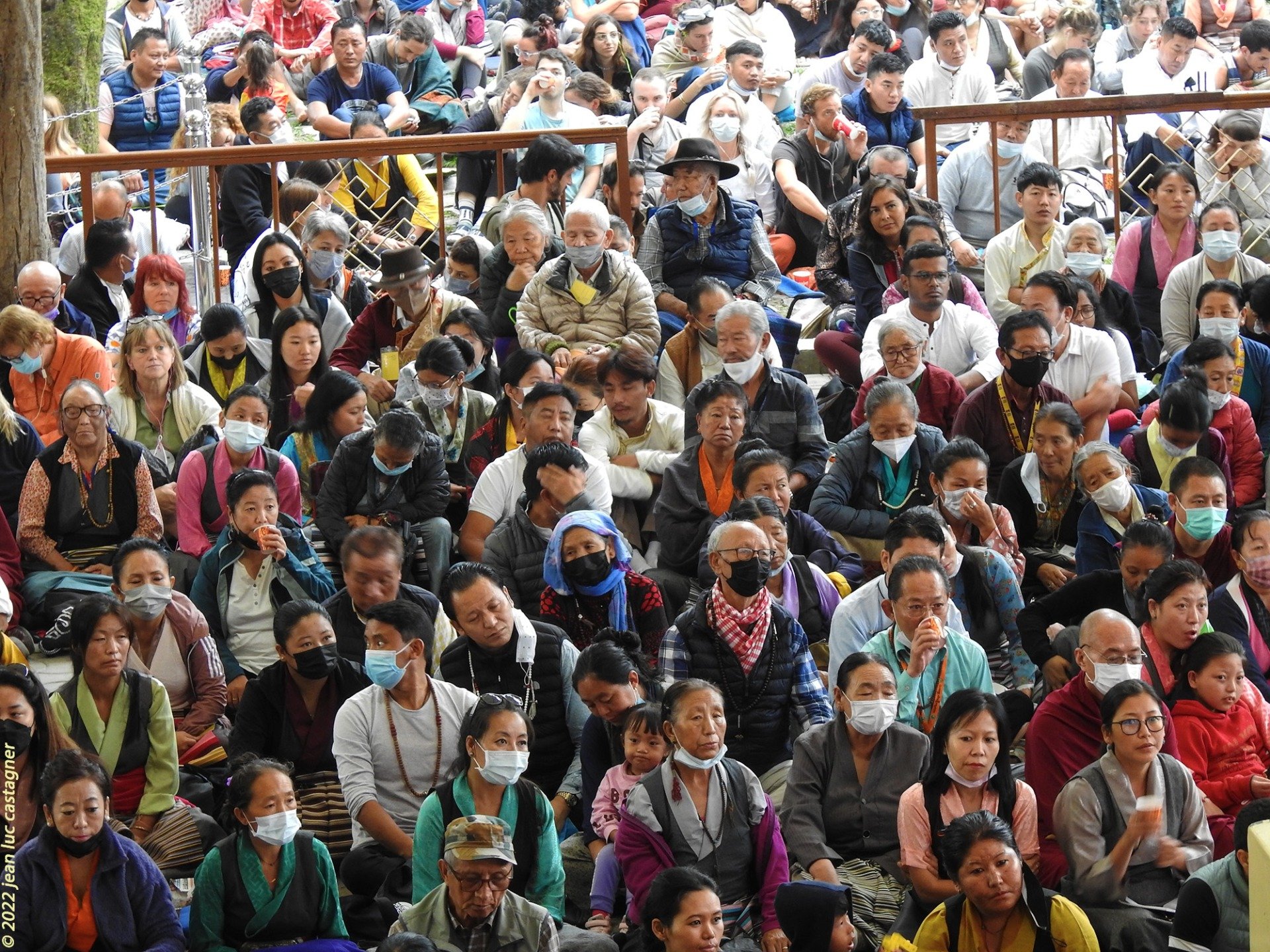
Attendees of His Holiness the Dalai Lama’s teaching, McCleod Ganj, H.P. India, September 2022. Photo by Jean-Luc Castagner.
These teachings were requested by a group of Southeast Asians and the majority of the foreign participants who attended were from Vietnam, Singapore, Taiwan, and China. However, this time there seemed to be less Westerners, as the space on the ground floor outside had plenty of room left for sitting. This was contrasted with the June 2022 teachings for which the doors were shut by 7a.m. as it had very quickly reached full capacity.
For those who had attended the teachings in previous years, not much change is actually visible. Externally of course some improvements have been added in the temple, such as the new elevators that allow His Holiness to access the teaching hall. The video cameras used to stream the teachings are increasing in number it seems, with even a wireless feed that follows His Holiness closely as he slowly makes his way to the temple from his residence.
Mimi is a young teacher from Singapore, who came here to be able to learn and develop insights about herself and others, and also to be as close to His Holiness as possible. The profound impact that these teachings had on her, in her own words, “Really, it’s all about being loving and affectionate. That was mainly something that encouraged me, to be fearless in overcoming selfish delusions and have courage in the heart. Any negative situation is an opportunity to practice more love and affection toward my mind and others, and see the transformation from within. The study of emptiness is to really be able to investigate over and over the cause and effect of an object you have been obsessing about, and then to be disciplined in the mind, to be able to bring reasoning, and not conclude simply.”
Dharma can be understood at many levels and used unconditionally in various areas of our lives. Whether we are full-time at work, have the leisure to travel the world, supporting our family, or living a celibate life; the teachings apply to all situations, because we experience it all with our mind. Alessia, a Russian girl from Moscow who has been studying Tibetan and Buddhist philosophy at the Library of Tibetan Works and Archives for five months now, said, “The most important is what is in my mind, if I have bad things from which I suffer, I have to work with myself. So it is not outside of me, it’s only my mind. This is the most important part.”
Change is also an inevitable part of our existence. Personally, my first visit to McLeod Ganj was in 2007, and for sure it was different than now, the number of hotels was considerably lower, eating out was restricted to a few good options, and the garbage situation was very difficult. Since then, McLeod Ganj has banned plastic bags, and there are now a few locations where waste can be left to be disposed of. Compared to then, the town is much cleaner, and the variety of dining options (Tibetan, Indian, Japanese, Italian, Korean, etc.) reflects well its cosmopolitan atmosphere. As a French person, I especially appreciate the famous cakes that made the reputation of a few places such as Coffee Talk near the temple.
For some like Dimitri, who has been living in McLeod Ganj for 10 years now, his take on the evolution of McLeod Ganj is double-sided, “It became more comfortable to live here, I know from before. If you want to study it’s good, but if you want to do practice or meditation, the atmosphere has changed for the worse, because there are a lot of tourists coming, a lot of distractions. Before it looked like a monk’s village, with monks doing prayers and reciting mantras, but now it’s a tourist place and the atmosphere is different. If I want to do meditation or go deeper into my practice, I move from here for a short time and I come back. But before it was not like this”
While staying in McLeod Ganj during the two years of the LRZTP, I remember noticing that the Tibetan community here had become very proactive with various environmental projects and regular demonstrations. If one reflects on the current state of our planet, it appears that mundane interdependence is not even valued nor considered at government levels. His Holiness’s timeless approach of the Buddha’s teachings manages to integrate and support the various issues that affect us all, such as how to deal with anger, stress, climate change, war, and epidemics within our minds. It is our duty as responsible Buddhists, who, like all sentient beings, do not wish to suffer and only wish for happiness, to uphold his message and advice and implement it in our daily lives to the best of our abilities. It is such a precious opportunity to attend these teachings and to see His Holiness directly. If you have the resources and time to visit McLeod Ganj, this will be very worthwhile. But be mindful as the cakes here are atrociously delicious.
Jean-Luc has been a student of Lama Zopa Rinpoche since 1998 and has been volunteering in various FPMT centers over the years, particularly in Institut Vajra Yogini and Nalanda Monastery near Toulouse, France. He recently graduated from the Lotsawa Rinchen Zangpo Translator Program in Dharamsala and is now pursuing his study of the Tibetan language in Nepal.
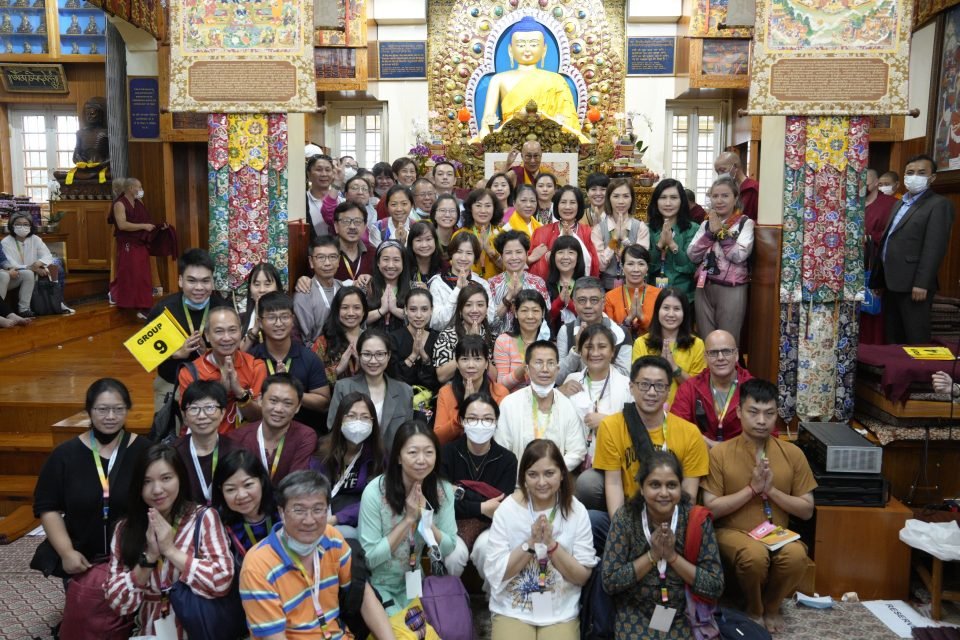
Southeast Asian group with His Holiness the Dalai Lama, September 2022. Photo courtesy of the Office of His Holiness the Dalai Lama.
Amitabha Buddhist Centre Students from Singapore Attend His Holiness’s Teachings
By Ven. Tenzin Tsultrim
An air of enthusiasm and excitement accompanied 33 of us on our Amitabha Buddhist Centre (ABC) tour to attend His Holiness the Dalai Lama’s teachings for Southeast Asian students in Dharamsala, India. Our week-long trip from September 11-19 was joyfully welcomed by all. In the interim, we had been thankful to be able to receive His Holiness’s precious teachings online and even through Zoom. However, nothing could compare to sitting in the gompa of Namgyal Monastery itself as His Holiness continued teaching from where he had left off previously in Chandrakirti’s Entering the Middle Way.
The majority of the ABC travel group are very new to the Dharma and to ABC, or are engaged with other traditions such as the Chinese Mahayana tradition or another religion. However, the rare opportunity to be able to actually see His Holiness in person was what drew many of them to sign up with our tour. We also welcomed back a father and son duo who were ABC members from 30 years ago!
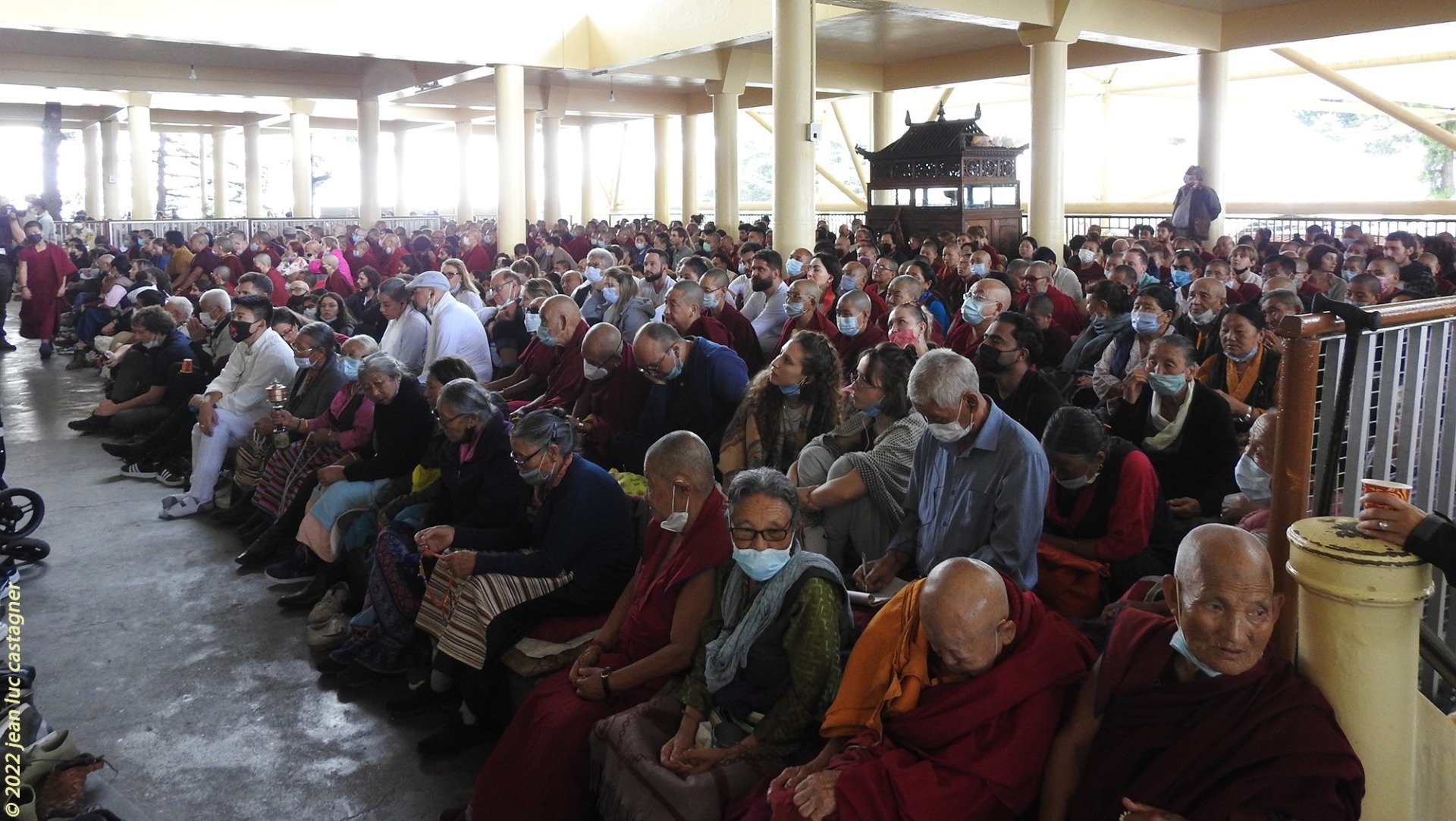
Some of the attendees for His Holiness the Dalai Lama’s teaching, McCleod Ganj, H.P. India, September 2022. Photo by Jean Luc Castagner.
Besides attending the two-day teachings at the main temple, our group had the opportunity for a pilgrimage to Tso Pema at Rewalsar, the sacred lake where Guru Rinpoche, Padmasambhava, is said to have been miraculously born from a lotus. The full-day road trip included visits to three holy caves where Guru Rinpoche had meditated. These included a cave where Guru Rinpoche had planted his footprint. We also sat in the first cave to meditate on Guru Rinpoche, recite the Sampa Nyurdrupma prayers, the mantra of Guru Rinpoche, and dedicate strongly for the peace and happiness of all beings in the world in these troubled times. One of the first-timers later shared that the experience of being able to do these prayers was very meaningful and special to her as she had never performed such prayers before. She was very grateful to be guided in this practice, saying that it was a memorable experience for her.
Another side tour for our group was a visit up to our sister center, Tushita Meditation Centre. Everyone showed themselves to be very good sports in taking the steep hike up the walking trail to Tushita – albiet puffing and panting here and there, but everyone made it! We were warmly welcomed by Tushita Centre’s Spiritual Program Coordinator, Ven. Kunphen. After a comprehensive briefing and tour of Tushita’s holy objects provided by Ven. Kunphen and her assistants, we were treated to a generous and sumptuous buffet that included momos, a variety of cakes and steaming cups of chai.
Other highlights for our participants included an audience with His Eminence Yongzin Ling Rinpoche, observing a post-teaching fire puja at Namgyal Monastery, and a visit to Gyuto Tantric Monastery and Norbulingka. Many also got to view the holy relics of the previous incarnation of Ling Rinpoche in a museum inside His Holiness’s private residence. To celebrate the end of our visit, we all sat down to a dinner together at the newly-refurbished Pema Thang Guesthouse restaurant.
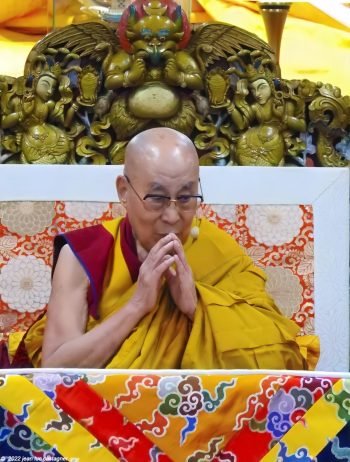
His Holiness giving teachings, McLeod Ganj, H.P., India, September 2022. Photo by Jean-Luc Castagner.
Very positive comments and feedback were heard all round, and there were many happy, beaming faces. One participant who was on her first visit to Dharamsala rated her experience as “5-star” and “A-plus!” It is remarkable that impermanence and our past accumulation of merit brought us over to Dharamsala and back, safe, sound, and filled with special memories and countless blessings. We look forward to receiving the next round of His Holiness’s teachings, so kindly and efficiently organized by Tibetan Buddhist Centre, Singapore.
Camaraderie, open-mindedness, warmth and understanding accompanied us throughout our nine-day tour. Besides the coordination efforts supplied by Executive Committee member Vincent Koh, Sangye Quek and myself, several of our group, older and newer members alike, stepped up readily to help where needed. Everyone contributed to making this a peaceful, happy journey!
Ven. Tenzin Tsultrim is regional representative for IMI Southeast Asia and a long-time member and student at Amitabha Buddhist Centre in Singapore.
To view the current teaching schedule of His Holiness, we invite you to please visit the official website of the Office of His Holiness the Dalai Lama. Most of His Holiness’s teachings offer a live webcast so please check the website regularly for opportunities.
His Holiness will give three days of teachings on the mornings of December 29-31 at the Kalachakra Teaching Ground, Bodhgaya. On December 29 and 30 His Holiness will give teachings on Nagarjuna’s Commentary on Bodhicitta (jangchup semdrel). On December 31 His Holiness will confer the Blessing of Twenty-one Taras (dolma 21 jenang). We look forward to sharing details about these precious teachings after the event.
- Tagged: dalai lama, his holiness the dalai lama
30
Fifty-third Kopan Meditation Course is Underway!
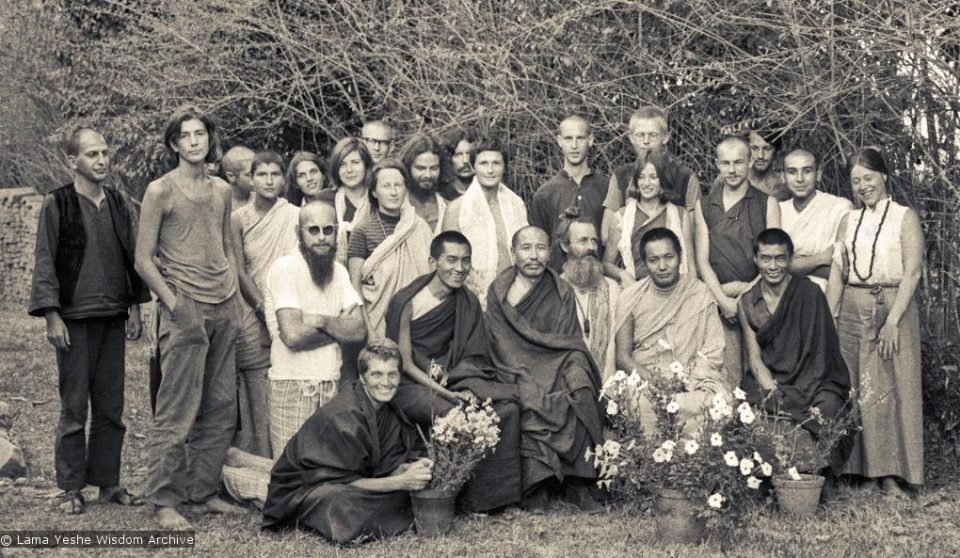
Group photo from the first meditation course held at Kopan Monastery, April, 1971. Left to right, front row: Zina Rachevsky, Lama Zopa Rinpoche, Geshe Thubten Tashi, Age Delbanco (Babaji), Lama Yeshe, Gen Wangyal. Fred Von Allmen is at far left, Claudio Cipullo second from the end on the right, and Mark Shaneman is standing directly behind Babaji. Photo provided by Fred von Allmen, courtesy of the Lama Yeshe Wisdom Archive.
Lama Zopa Rinpoche has said, “Coming to a Kopan Course is the most important education of your Life.” On November 25, 2022, after a two year break due to the COVID restrictions and safety concerns, 175 students started the fifty-third course at Kopan Monastery with Geshe Tenzin Namdak serving as retreat teacher. A more restricted amount of attendees were admitted than usual due to ongoing concerns of contagion and risks.
The organizers report that the flow has been smooth and things are going well and harmoniously so far. Geshe Namdak has started the teachings with a scientific approach. His teaching manner has been described as relaxed yet enthusiastic. In attendance are a combination of senior students, including eight nuns, three monks, and complete beginners from all around the world, including a large group of Spanish speaking students and a smaller Portuguese group.
Many of FPMT’s senior students first met Lama Yeshe and Lama Zopa Rinpoche attending one of these retreats and over the years, thousands of students have made a connection with FPMT through the education they received at Kopan Monastery. For three years in the seventies, two courses were offered every year, and since then, the November Course—as it is affectionately referred to—was offered every year until 2020.

Lama Zopa Rinpoche, Kopan Monastery, Nepal, December 2017. Photo by Bill Kane
In 2017, Rinpoche told the 200+ attendees of the course, “So it is really of the utmost importance, you coming here to learn not just meditation but lamrim, lamrim meditation. … Only then, you can understand how to live life, how in the past how you live, and how you should live now, in a positive way to benefit not only yourself but all the numberless beings. So I want to say, your coming to Kopan to do meditation course, oh, this is the best! If you want to help the world, to bring peace, your coming here is the best. Your coming here to do the meditation course, to learn, that is the best. You have to bring peace in the world by your mind, by your good heart. You yourself have to have a good heart to bring perfect peace and happiness in the world. That is the best.”
Lama Zopa Rinpoche taught that very first course in 1971 and has offered teachings at the courses almost every year since. In addition to Rinpoche’s teachings, which usually begin a couple of weeks into the course, Rinpoche selects a course teacher to lead the course every year. Geshe Namdak, who was requested this year, is resident teacher at Jamyang London Buddhist Center. Geshe Namdak is a Dutch senior monk who completed his Geshe Degree at Sera University in India in 2017. Geshe Namdak is the first Westerner to complete the full course of studies at Sera Je Monastery and also to sit for the final geshe examination there, a tremendous achievement.
Please read more about Geshe Tenzin Namdak in a recent in-depth story, ” Bringing the Teachings Alive: Geshe Tenzin Namdak Encourages Students with Innovation and Patience.”
You can read more details about the historic first Kopan Meditation Course.
Lama Zopa Rinpoche is the spiritual director of the Foundation for the Preservation of Mahayana Tradition (FPMT), a Tibetan Buddhist organization dedicated to the transmission of the Mahayana Buddhist tradition and values worldwide through teaching, meditation and community service.
- Tagged: kopan course, November course
- Home
- News/Media
- Study & Practice
- About FPMT Education Services
- Latest News
- Programs
- New to Buddhism?
- Buddhist Mind Science: Activating Your Potential
- Heart Advice for Death and Dying
- Discovering Buddhism
- Living in the Path
- Exploring Buddhism
- FPMT Basic Program
- FPMT Masters Program
- FPMT In-Depth Meditation Training
- Maitripa College
- Lotsawa Rinchen Zangpo Translator Program
- Universal Education for Compassion & Wisdom
- Online Learning Center
- Prayers & Practice Materials
- Overview of Prayers & Practices
- Full Catalogue of Prayers & Practice Materials
- Explore Popular Topics
- Benefiting Animals
- Chenrezig Resources
- Death & Dying Resources
- Lama Chopa (Guru Puja)
- Lama Zopa Rinpoche: Compendium of Precious Instructions
- Lama Zopa Rinpoche: Life Practice Advice
- Lama Zopa Rinpoche Practice Series
- Lamrim Resources
- Mantras
- Prayer Book Updates
- Purification Practices
- Sutras
- Thought Transformation (Lojong)
- Audio Materials
- Dharma Dates – Tibetan Calendar
- Translation Services
- Publishing Services
- Teachings and Advice
- Find Teachings and Advice
- Lama Zopa Rinpoche Advice Page
- Lama Zopa Rinpoche: Compendium of Precious Instructions
- Lama Zopa Rinpoche Video Teachings
- ༧སྐྱབས་རྗེ་བཟོད་པ་རིན་པོ་ཆེ་མཆོག་ནས་སྩལ་བའི་བཀའ་སློབ་བརྙན་འཕྲིན།
- Podcasts
- Lama Yeshe Wisdom Archive
- Buddhism FAQ
- Dharma for Young People
- Resources on Holy Objects
- Ways to Offer Support
- Centers
- Affiliates Area
- Teachers
- Projects
- Charitable Projects
- Make a Donation
- Applying for Grants
- News about Projects
- Other Projects within FPMT
- Support International Office
- Projects Photo Galleries
- Give Where Most Needed
- FPMT
- Shop
Translate*
*powered by Google TranslateTranslation of pages on fpmt.org is performed by Google Translate, a third party service which FPMT has no control over. The service provides automated computer translations that are only an approximation of the websites' original content. The translations should not be considered exact and only used as a rough guide.The sun of real happiness shines in your life when you start to cherish others.







